Trawler vs. Sail
Trawler versus sail—a comparison that is often dismissed as an old-person versus young-person, apples-to-oranges argument. It’s assumed that a sailor will sail until his hands are too crippled to manage a line any longer, then buy a trawler that will sit dockside, until one day a dockmaster is notified of a disturbing smell coming from “that boat the old guy lives in.”
But maybe there is more to it. Maybe sailors can get tired of sailing, sometimes, and we can wonder just how much we would really miss it if there were no sails to raise. When I was ready for my next family boat, I had no problem whatsoever coming to the conclusion that I wouldn’t miss sails. I really should say we had no problem, as the choice was very much a mutual one with my wife, Ali—and our kids didn’t care as long as they were back on the water.
For a quick background check on my credentials, let me just point out that Ali and I sailed around the world on our 35′ catamaran, and also spent a few years bopping around the West Coast of the U.S. and Mexico on a 43′ monohull—thus giving myself some rolly-polly boat cred, as well. I discussed the catamaran versus monohull debate here and here. I think we all know how that debate turns out, don’t we? If we’re being honest.
After about 8 years, 65 countries, and 45,000 miles in boats with floppy white things, and small engines, my family moved on to an entirely different kind of cruising—trawler.
We bought a 1986 42′ Grand Banks in Florida two years ago, spent a cruising season putting a couple thousand miles on her through the Bahamas, Turks and Caicos, and back to Florida. This season we visited Key West and then headed west across the Gulf to Mexico, with plans to continue south through Central America.
During this time we’ve established some pretty strong opinions about the trawler versus sail debate, so I’m going to lay it out here now.
Purchase Cost
Our 35′ catamaran was just a year old when we bought it for $157,000. It didn’t need any work in order to take off and cruise. We added a watermaker, replaced the batteries, and set off to sail around the world.
The monohull was a 1982 43′ Spindrift that had sat in a marina in the Sacramento Delta for a dozen years. The engine was half underwater, and the decks were degrading—but the interior was still in beautiful, like new condition, and the layout of the pilothouse was exactly what we wanted for our family of three. We bought it for $48,000, sight unseen off of Craigslist, and moved aboard with our six-month-old baby girl.
Our 42′ Grand Banks cost $120,000. We’re now a family of four, and this boat fits. The teak decks are getting a little long in the tooth, but aside from that it is in amazing shape. The engine room immediately sold me on this boat. Immaculate, huge, and obviously well cared for. The interior woodwork was exceptional, and every single thing on the boat worked. Even the exterior fiberglass looks like it was laid yesterday. For a thirty-three year old boat, it looks fabulous.
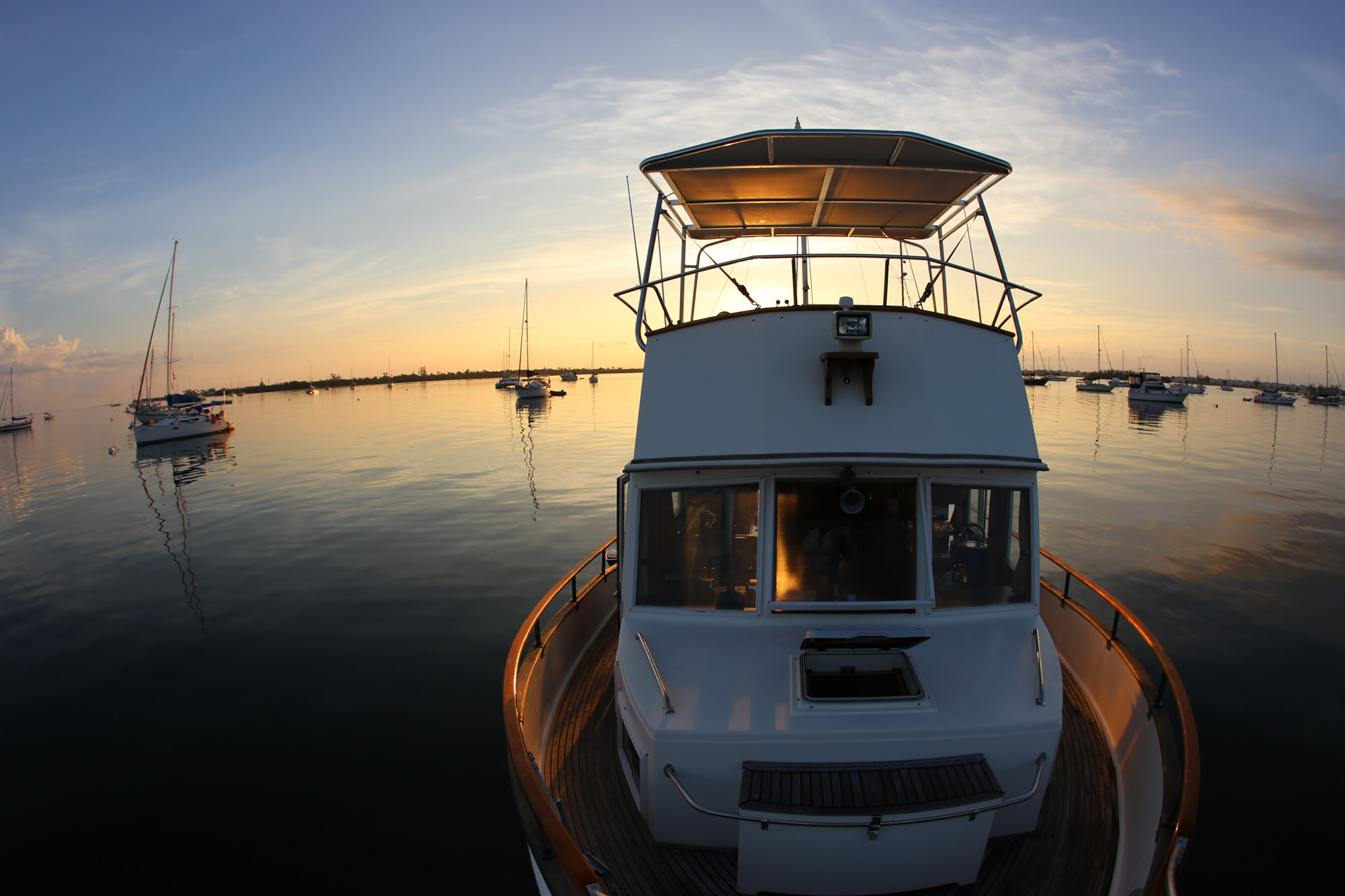
This category may be the only one that a monohull sailboat can win. A bluewater capable monohull in the 32-43′ range, that doesn’t cost an arm and a leg, are a dime a dozen. You can get trawlers dirt cheap as well, but most of those will be found lacking in quite a few details in order to truly be considered blue-water capable. As for a catamaran at a reasonable price, forget it.
Space
When people unfamiliar with trawlers step inside our boat for the first time, their jaws drop. It may only be 42 feet, but the space it affords is enormous—it has comfortable living space, from one end to the other.
The aft stateroom on the Grand Banks is our two kids’ room, with a twin bed on one side, a full-size bed on the other, a dresser, enough floor space for two kids and all their toys, and a very large closet. Ceiling height in this room, as well as everywhere else in the boat, is well clear of my 6′ 2” and never requires stooping. Not many sailboats can say that.
The galley and saloon are extremely roomy and well laid-out, with two large refrigerator/freezers, two couches, a big table, acres of windows, and light. Yes, light! Something our monohull was always lacking, despite the fact that it was a pilothouse with lots of windows.
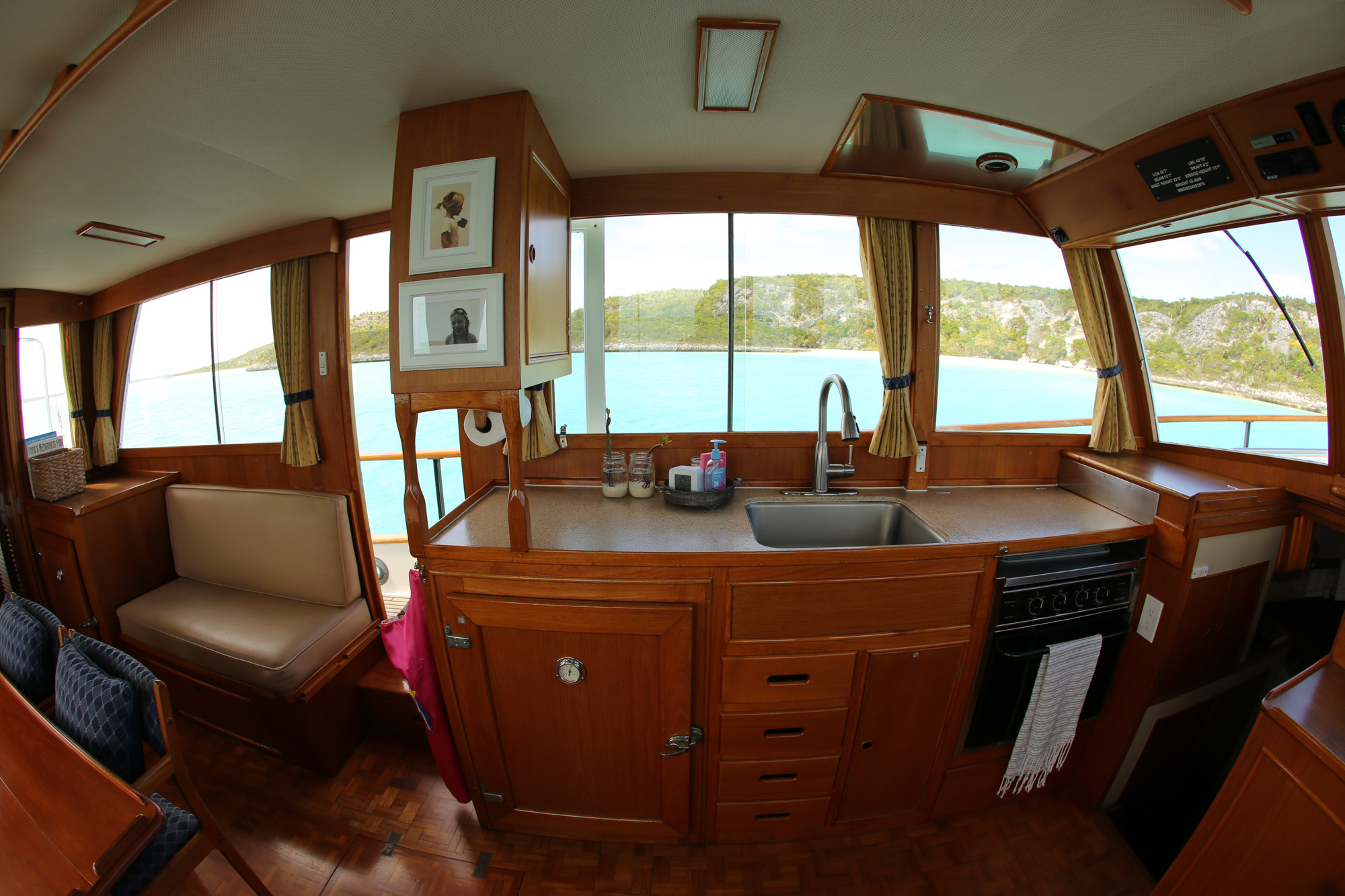
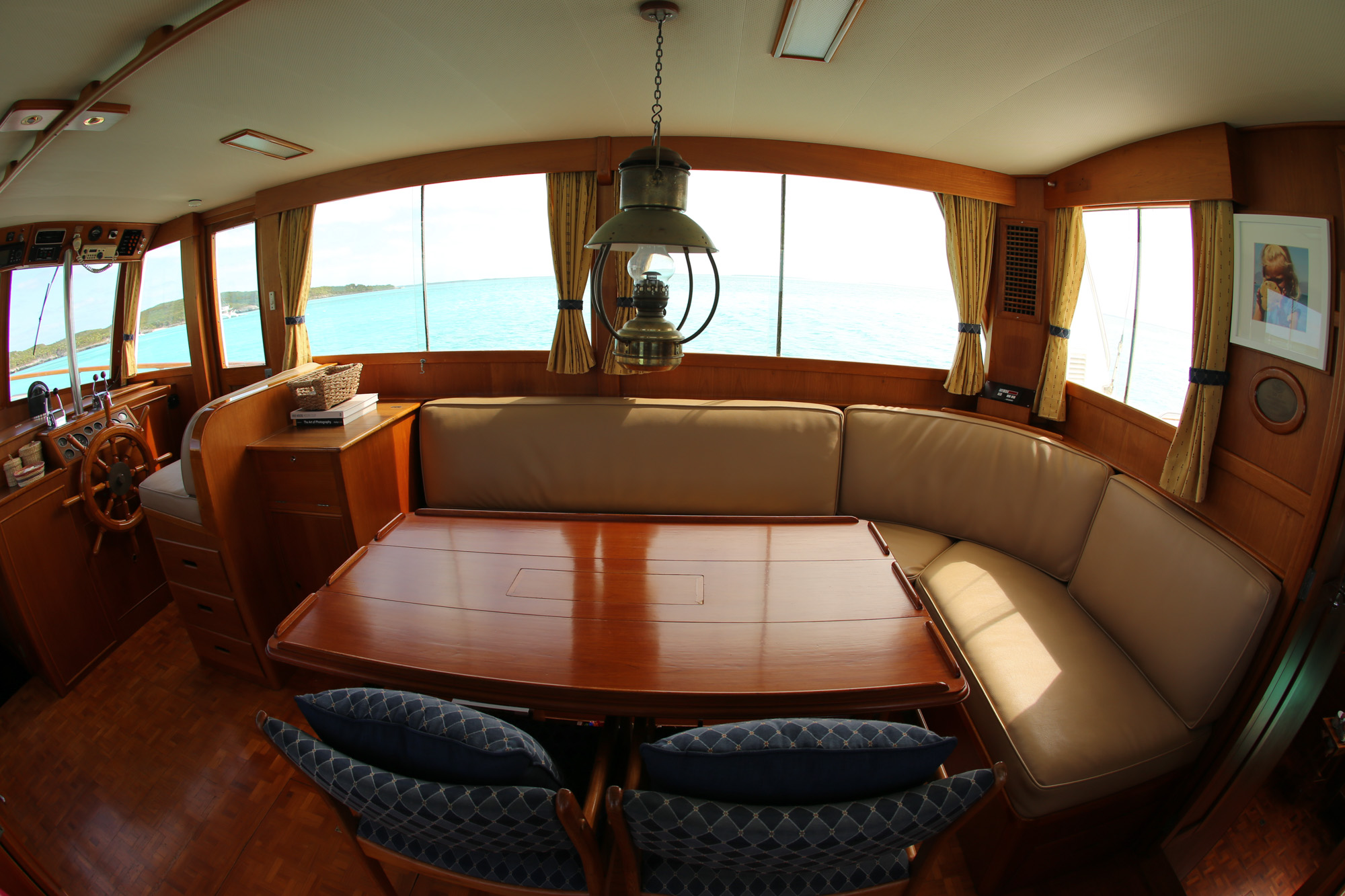
From a strictly “enjoyable living space” perspective, the trawler crushes the competition. Our 35′ catamaran essentially had a 24” runway of floor space through the saloon, and down the two hulls. The only space in the boat to truly spread out was on the couch, or in bed—it had no chairs, or floor to just flop down on, which is a big deal when kids are part of the equation.
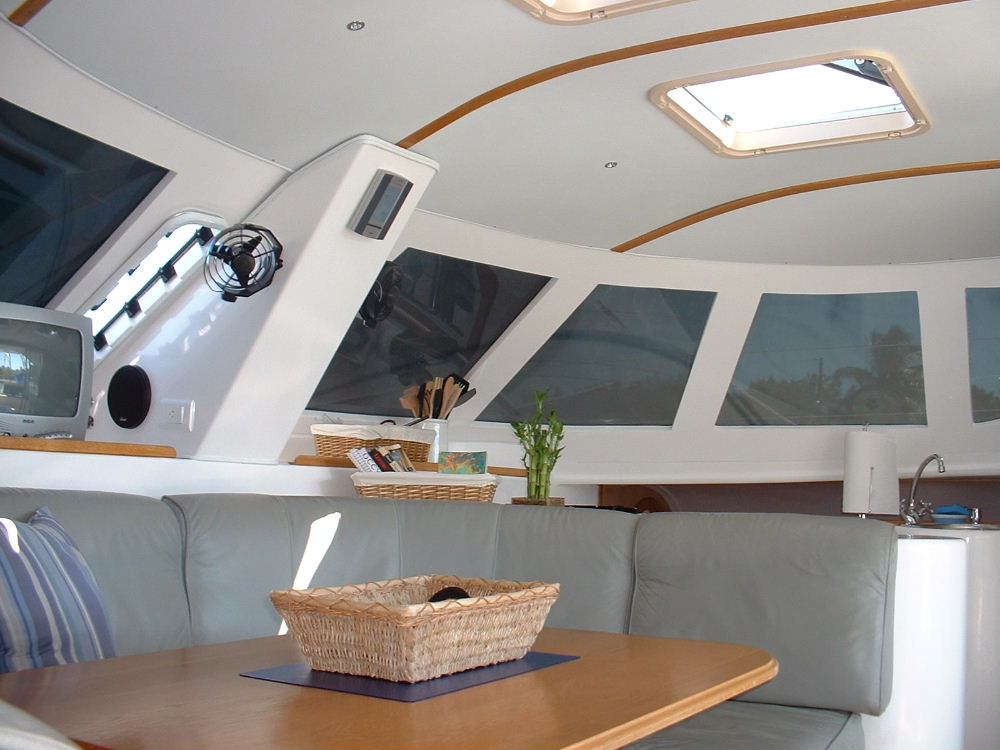
Our 43′ monohull was a step up from our catamaran in the living space department. We gained seating space, as well as room to just stretch our legs, but we completely gave up deck space. Gone were the days of the catamaran’s big, comfortable cockpit, swim platform, and trampolines. In exchange we received a cockpit area that two people could lie uncomfortably, or four people could sit with their knees touching.
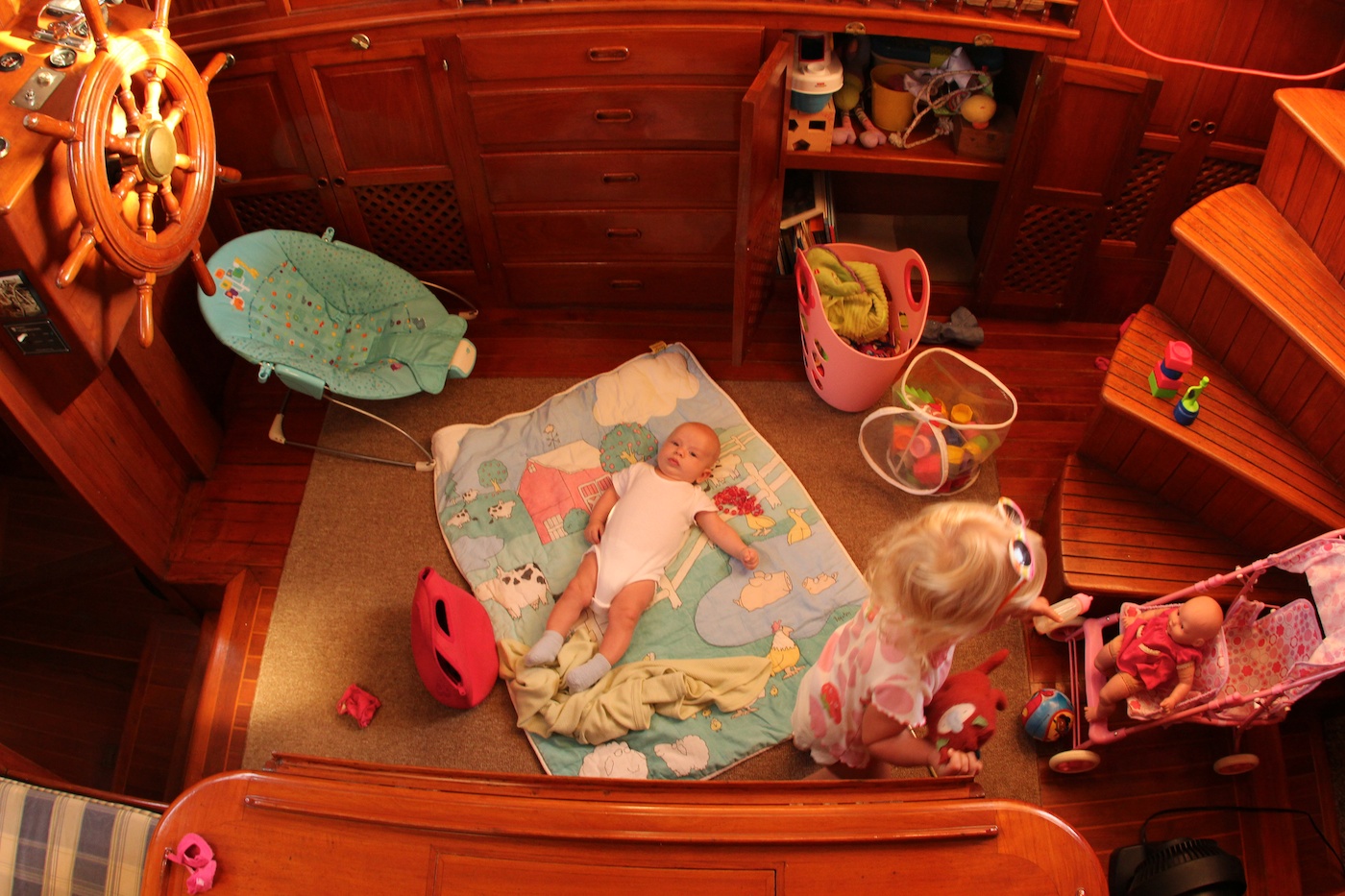
The trawler trounces both boats with ease. Inside is so much space you feel like dancing across the floors in a Sound of Music style. Out on deck, the flybridge is a massive space with unobstructed views, seating for a dozen, and floor space for an extra long Matchbox racetrack. The swim platform is incredible—nothing beats sitting there at anchor with your feet in the water. It almost seems like it was designed specifically with active kids in mind.
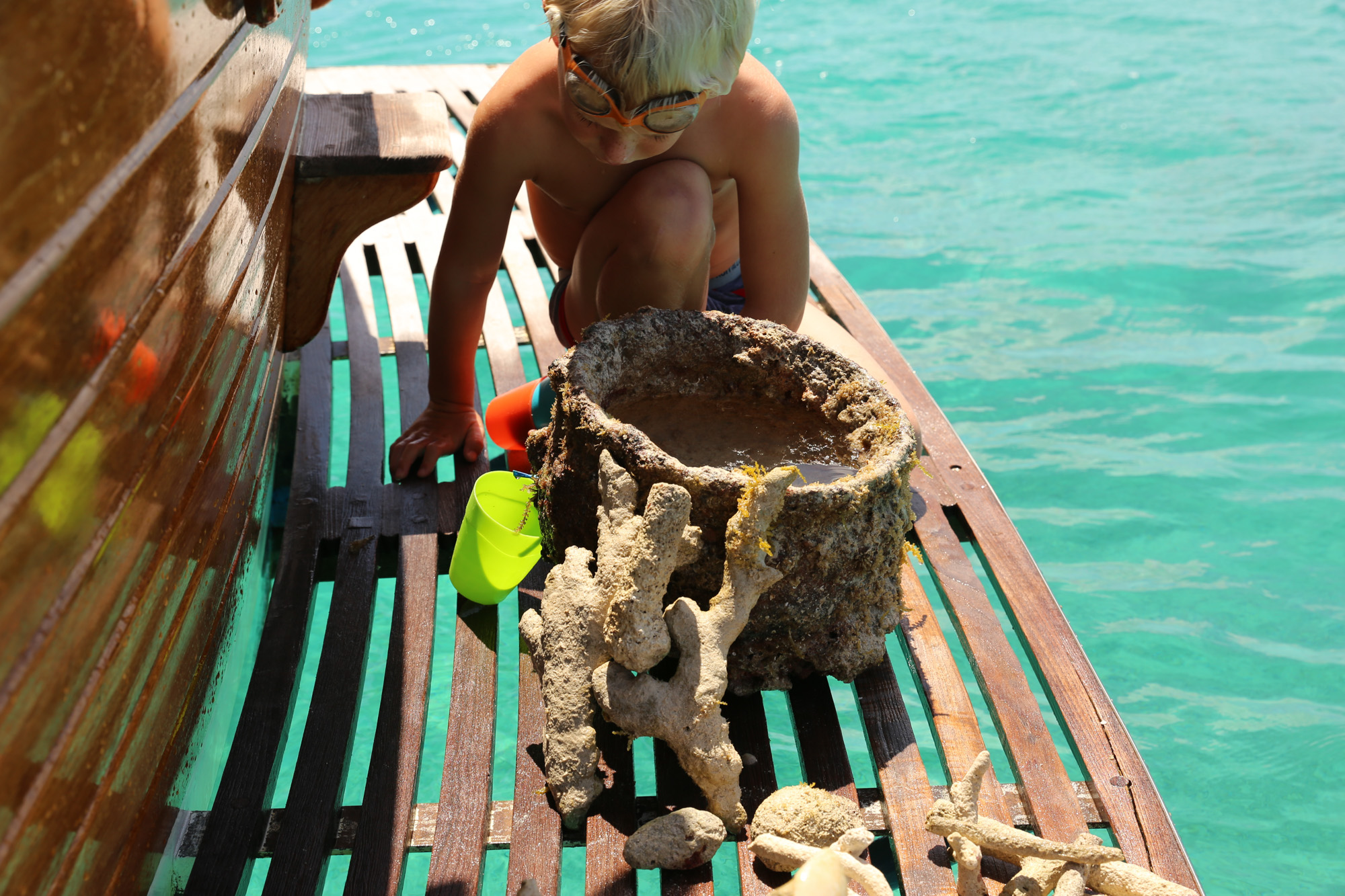
As for storage space, well, that’s pretty impressive as well. Inside has the standard closets, cabinet, and under seat storage space that you’d find on any boat of similar size. The trawler might hold a small lead, though it’s not overwhelming. But then you start to poke around the rest of the boat. All your spare parts fit comfortably in bins stored easily in the enormous engine room. A dozen docklines fit easily in the bow locker. And the aft lazarette holds everything else a person could ever need on a boat.
Our monohull and catamaran combined wouldn’t hold a candle to the trawler’s space. Finally, in case you are a hoarder, there is more storage under the seats on the top deck, as well as under the steering station. When we moved aboard we found a total of twenty-seven life jackets onboard. I’m certain this was because they simply forgot where they were all stored, and just kept buying more.
Advantage, absolutely, positively, trawler.
Engines
Our catamaran had two little Volvo 20hp engines, and was exceedingly, painfully, slow under power. Granted, it sipped diesel, but I would have traded fuel economy for power a hundred times, at least, during our time on that boat. Top motoring speed, 4.0 knots. In addition, the engines are located underneath the beds, meaning hot beds at night, and a workspace that includes needing to pull mattresses completely out of the room.
It was a welcome change when we moved to the monohull and graduated to a Ford Lehman 80. Yet even that good-sized engine could only shove our beast of a full-keeler to 5.6 knots at normal RPMs. On the plus side, the engine space was much larger and easier to work in, though still a long way from enjoyable. I did however appreciate being able to fit a five gallon bucket under the oil pan for changes.
Now, in the Grand Banks, we’re powered by twin Ford Lehman 135s, and it is a thing of beauty. Calculating our ETA to the next island using an input of 8.5 knots is a wonderful feeling. And, oh boy, can I bend your ear raving about the massive engine room.
But wait, I hear the sailors saying, “We sailboat cruisers don’t care about how fast we can go, or what our motoring speed is, we just capture the wind and go where it takes us.” To which my only reply is, “You must be new here.”
Are there exceptions to the rule—the rule that states that 90% of sailors will sail just 10% of the time? Sure. Every sailor thinks they are the exception, but experience, and truthfulness, will soon tell them otherwise. We’re all motorboaters in the end.
Stability
Catamarans, obviously, are well known for their stability. In a mono versus cat debate it would take an incredible imagination to argue in favor of the monohull. Anyone who says they prefer the rolling of a monohull to the slightly jerky, but flat, motion of a catamaran is either certifiably insane, or… no, they are definitely insane.
People can claim to enjoy heeling over, but anyone who has done multi-day passages knows full well how exhausting it eventually is to live on a hill. It’s just impossible to argue a case for the monohull. And any captain who prefers that the crew he’s got with him not spend their days barfing over the side of the boat, will attest to the beauty of the catamaran design.
So how does a semi-displacement trawler handle the ocean?
Ahhh, that’s where we got lucky. Honestly, I didn’t know a thing about stabilizers before we bought our boat. When I saw on the sale listing that it had stabilizers, I gave that news about the same affirming nod I gave to the listing pointing out the autopilot.
But there they were—Naiad stabilizing fins on each side of the boat. We bought our boat in St. Augustine, Florida, and it wasn’t until we set off down the ICW that I hit the buttons to activate them for the first time. A while later, a typical ICW speedboat went past, throwing up a wake that would strike fear into even the most hardened monohull sailor. I steered a straight line, not even turning to point into the waves, and the experience was transcendant—a trawler that handles waves like a catamaran.
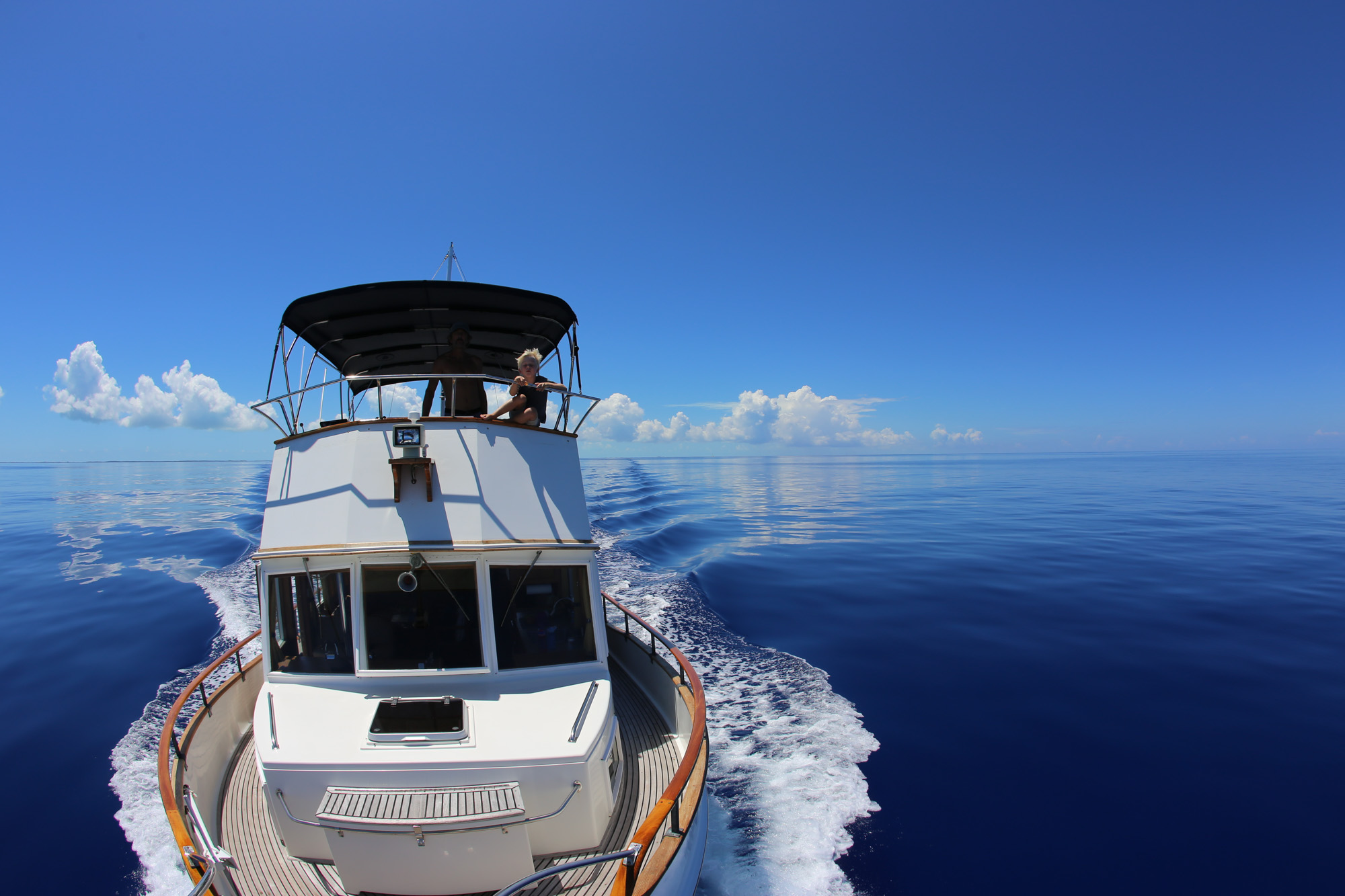
A catamaran gets the win for stability. Everyone knows that. It’s a stable flat platform both underway and at anchor, and frankly, that’s the number one reason 99% of catamaran owners would cite for their choice of boat.
A monohull sailboat? Forget it—there’s nothing stable about a monohull in any condition.
A trawler with stabilizers? Such an incredibly close second-place finish. Underway, our trawler is a virtual equal to our catamaran. In fact, I’d give it a slight nod because of the weight and its ability to smash through waves on the nose without losing momentum the way the cat would. At anchor, the trawler suffers almost the same maladies that a monohull does—a wraparound swell will always drive you nuts. The trawler doesn’t seem to build the momentum of the pendulum that a mono sailboat does, but it will get rolling all the same. This past season I laid out a back anchor in at least half a dozen anchorages around the Bahamas to get our bow pointed into the swell. In each of those instances, the catamaran likely wouldn’t have been bothered much.
Operating Cost
Sailboat owners immediately point out fuel costs as an argument against a trawler, so let’s tackle that issue right off the bat.
Our cruising on the trawler so far has been typical of a lot of users. We motored down from north Florida, over to the Bahamas, down to the Turks and Caicos, back to central Florida, down to the Keys, and across to Mexico. From here we’ll head to Guatemala to wait out another hurricane season. All told, about 3,500 miles. Our total fuel cost (we won’t need more before hurricane season) is $7,702 for those two years. At an average price of $4.64/gallon ($3.25 in the U.S, and up to $5.25 in the islands). Break it down and that’s $320 per month.
Let’s do some back of the napkin math and assume a sailboat motored half the time (that’s being extremely generous to sailboat cruisers in the islands, for whom the average is likely closer to 90%). 1,750 miles, at five miles to the gallon, is 200 gallons, or $1624—$68 per month. Everybody is different, and for some the $252/mo difference might be a deal breaker. I can’t really say. For us, fuel is about 8% of our total annual expenditures, and is considered just another cost of living.
However, let’s not forget that running costs really include more than just diesel. There are oil changes to deal with, and basic engine maintenance. These all vary wildly, but it’s safe to say that a trawler with twin Ford Lehman 135hp engines is going to cost more to maintain than a monohull with a single 80hp, or a cat with twin 20hp.
On the other hand, a trawler doesn’t have running rigging to deal with. What’s a new mainsail cost? How about that 150′ spinnaker halyard? Or standing rigging to keep that 50′ mast from tumbling down in the first big blow? A trawler will never incur any of these substantial costs. And you might think, how is a spinnaker halyard a substantial cost? Put it this way—at $2.50/ft for that line, that’s $375, broken down over a year, that’s a $31/mo expense that the trawler didn’t incur. Will that line need to be replaced next year? No, but some other one will, or a block that it runs through, or some other fancy stainless steel clip. Point is, it all adds up. One year will be more, one year will be less, but that doesn’t mean these costs don’t exist for sailors.
In the end, I’ll concede an edge to the sailboat owner in running costs, but it is a lot slimmer margin than most people would like to think. Slim enough that for many people it will be inconsequential.
Range
The only thing our Grand Banks isn’t capable of doing is cross major oceans. We’re not going to go across the Atlantic or Pacific in this boat. But, of course, we knew that when we bought it. Anyone planning a circumnavigation isn’t going to be debating trawler versus sail—that is, unless they are in the million dollar boat market.
Our Grand Banks carries 600 gallons of diesel, which I figure gives us a safe range of somewhere around 800 miles, with a few hundred miles of margin built in to give us considerable leeway in case something went wrong along the way.
Where can an 800 mile range take us? Well, anywhere in the Great Loop North America, down through the Caribbean island chain, around the entirety of the Caribbean Sea, through the Panama Canal, and right on up Central America, Mexico, and the west coast of the U.S. and Canada to Alaska. That’s a whole lot of cruising grounds to cover, and is more than enough adventure for all but the hardiest cruisers. Unless you are circumnavigating, there are very few places that you can’t reach in a trawler.
Technically, a sailboat wins here, but realistically, for almost every boat owner, cruising range is a tie. Those with plans to cross major oceans already know they need sails.
Miscellaneous
Marinas. Obviously, most marinas aren’t set up for the beam of a catamaran, will have fewer spaces available, and more and more often these days will charge 1.5-2x as much per foot as a monohull.
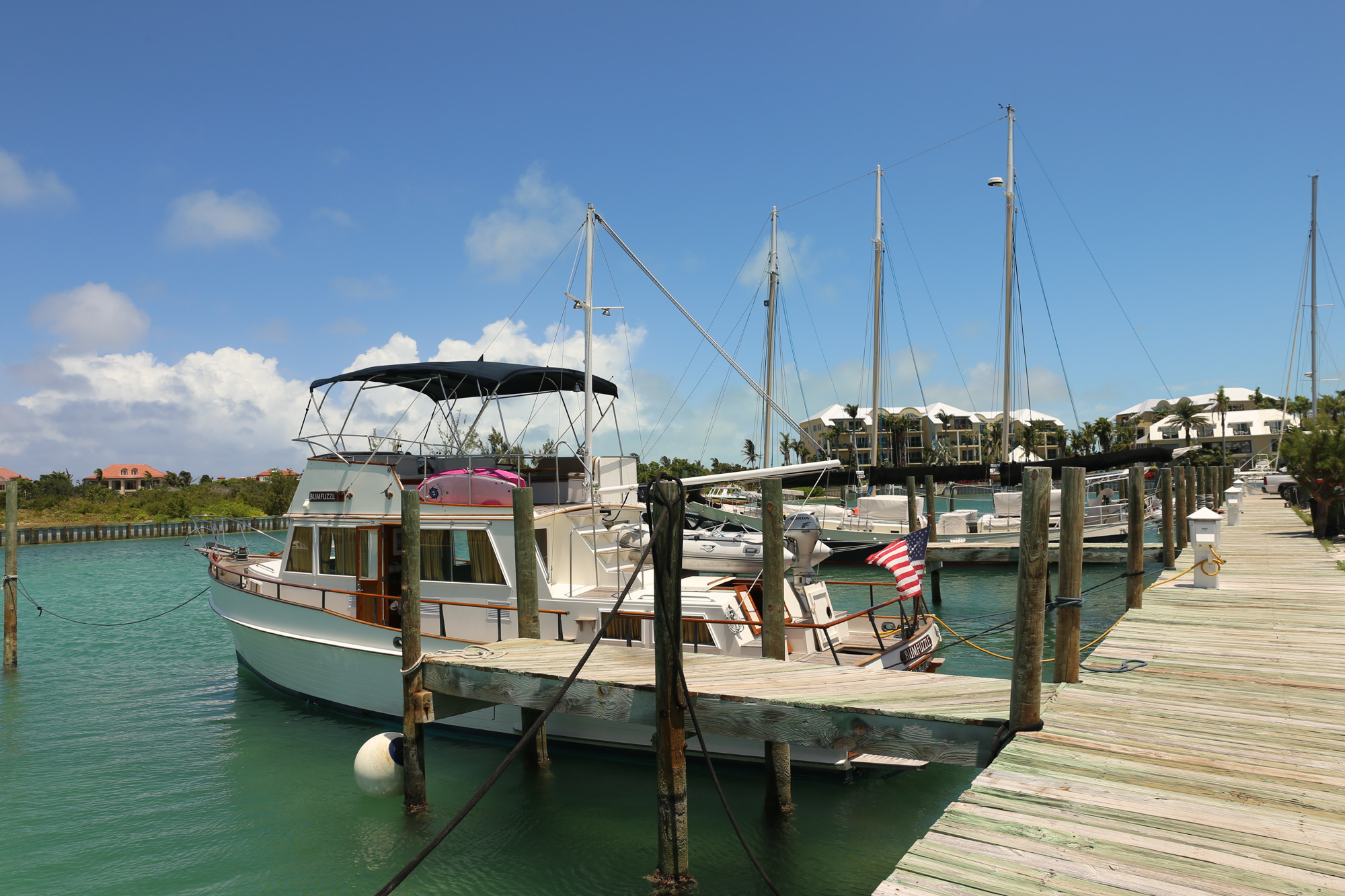
Draft. The Grand Banks is 4′ 2”, and can get just about anywhere a similar sized catamaran can. Monohulls with their 5.5′ or more, can, and will, cause issues in the islands. It’s not a deal breaker, but it is something that shallow drafters in cats and trawlers are happy to not have to think much about.
Added Weight. A cat is built to be light, meaning smaller water and fuel tanks. Our catamaran held just 70 gallons of water and 60 gallons of diesel. Our other boats held closer to 5 times as much of each. As cruisers we always add 300 feet of chain to our anchoring tackle as well, which is quite a bit of extra weight for a catamaran, but won’t even budge the waterline on a heavy monohull or trawler.
Bridges. Not a very common issue for most people, but anyone who would like to spend some time on the ICW is going to quickly despise the waterway if they have a mast. I found cruising the Florida ICW to be a very enjoyable experience in the trawler.
View. It may be a little thing, but I really love the feel of sitting up on the flybridge while underway. The view of the water is spectacular compared to the cockpit of a monohull, or the forward view from a catamaran’s little captain’s chair tucked behind the cabintop.
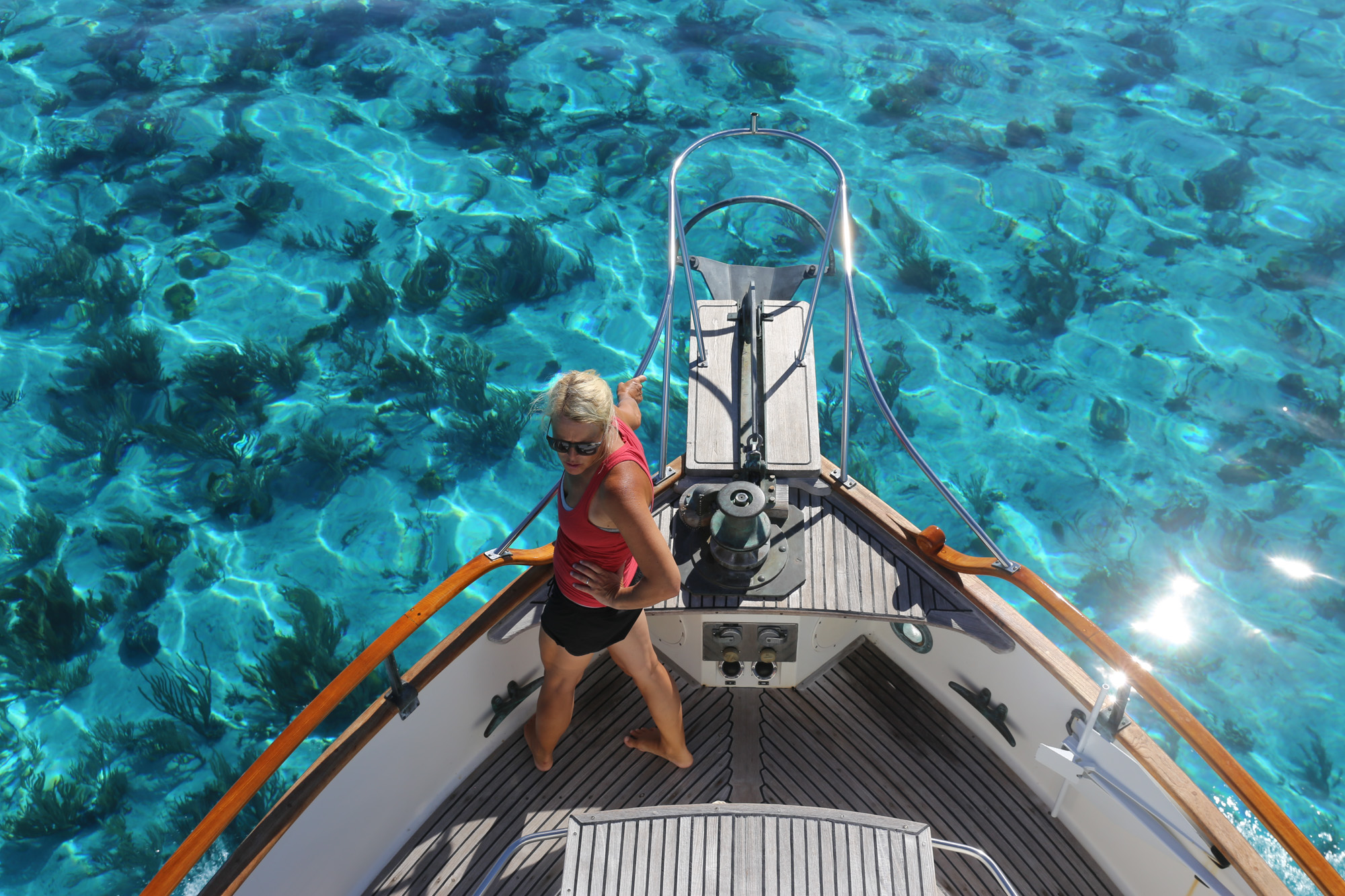
Conclusion
Everyone needs the right boat for the right job. Being a circumnavigator I often tend to think of things in terms of long-distance ocean voyaging, but then I step back and realize that only the tiniest fraction of liveaboard cruisers are going to—or even want to—sail around the world, or across major oceans. For those that do, if they’ve got the money, the obvious choice is a catamaran.
For the more common coastal cruiser, island hopper, Great Looper, there are other choices. With a budget under $80,000 the best bang for the buck is likely going to be a monohull. At that price you can get a well-equipped strong boat. It won’t win any awards for storage or comfort, but it’ll get you out on the water cruising, and ultimately that’s what is most important.
Over $80,000 I think a trawler wins the award for most versatile. We wouldn’t trade our trawler for any monohull sailboat. Both the indoor and outdoor space win hands down over a monohull. The huge engine room blows away any mono I’ve ever seen. And even the stability (admittedly due to the stabilizers) is incredible. We love every single aspect of our trawler more than our monohull.
So, to wrap up, if you just want to go cruising, and don’t have any plans to venture more than a couple hundred miles from land, buy a trawler and you won’t be disappointed. If you’ve got a few hundred grand burning a hole in your pocket and want to have the opportunity for passages of more than a couple of days, grab yourself a catamaran, and if you just really want to get out on the water, but the pocketbook isn’t as thick as you’d like, get a monohull and go enjoy life at sea.
| COST | OCEANS >600 MILES | ISLAND HOPPING |
|---|---|---|
| under $80k | Monohull | Monohull |
| $80-200k | Monohull | Trawler |
| over $200k | Catamaran | Trawler/Catamaran |

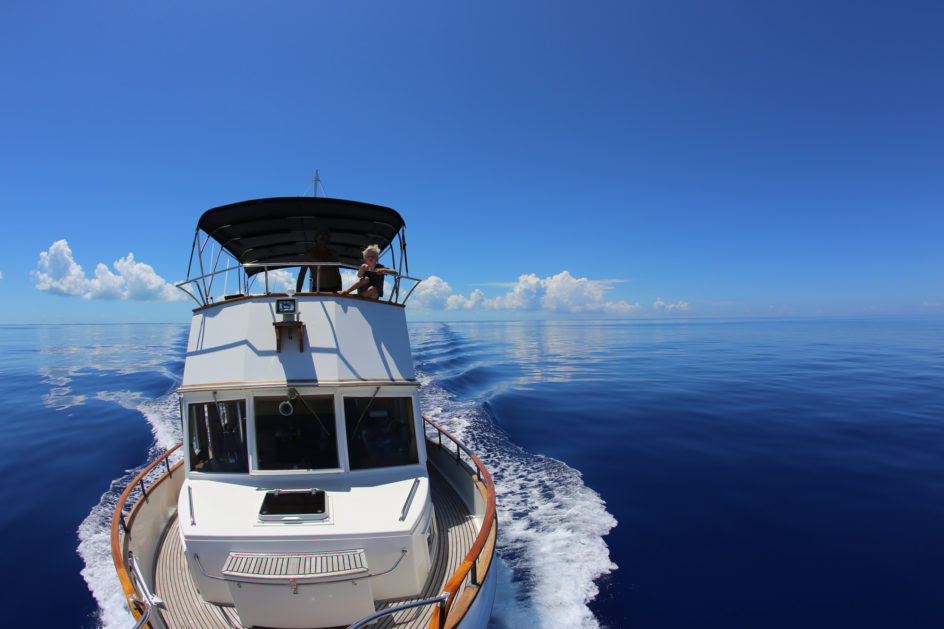
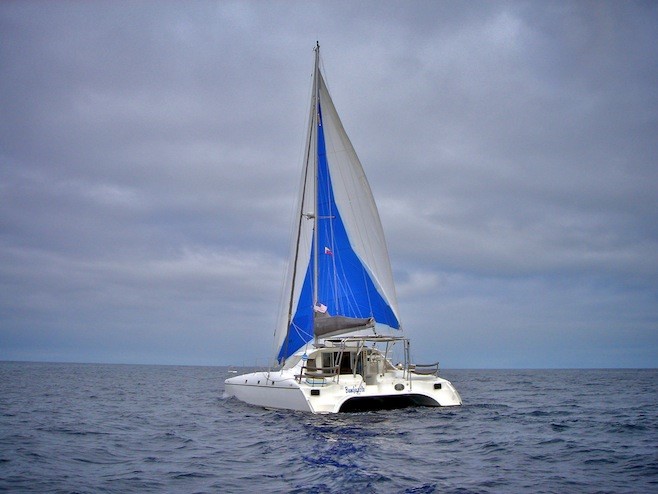
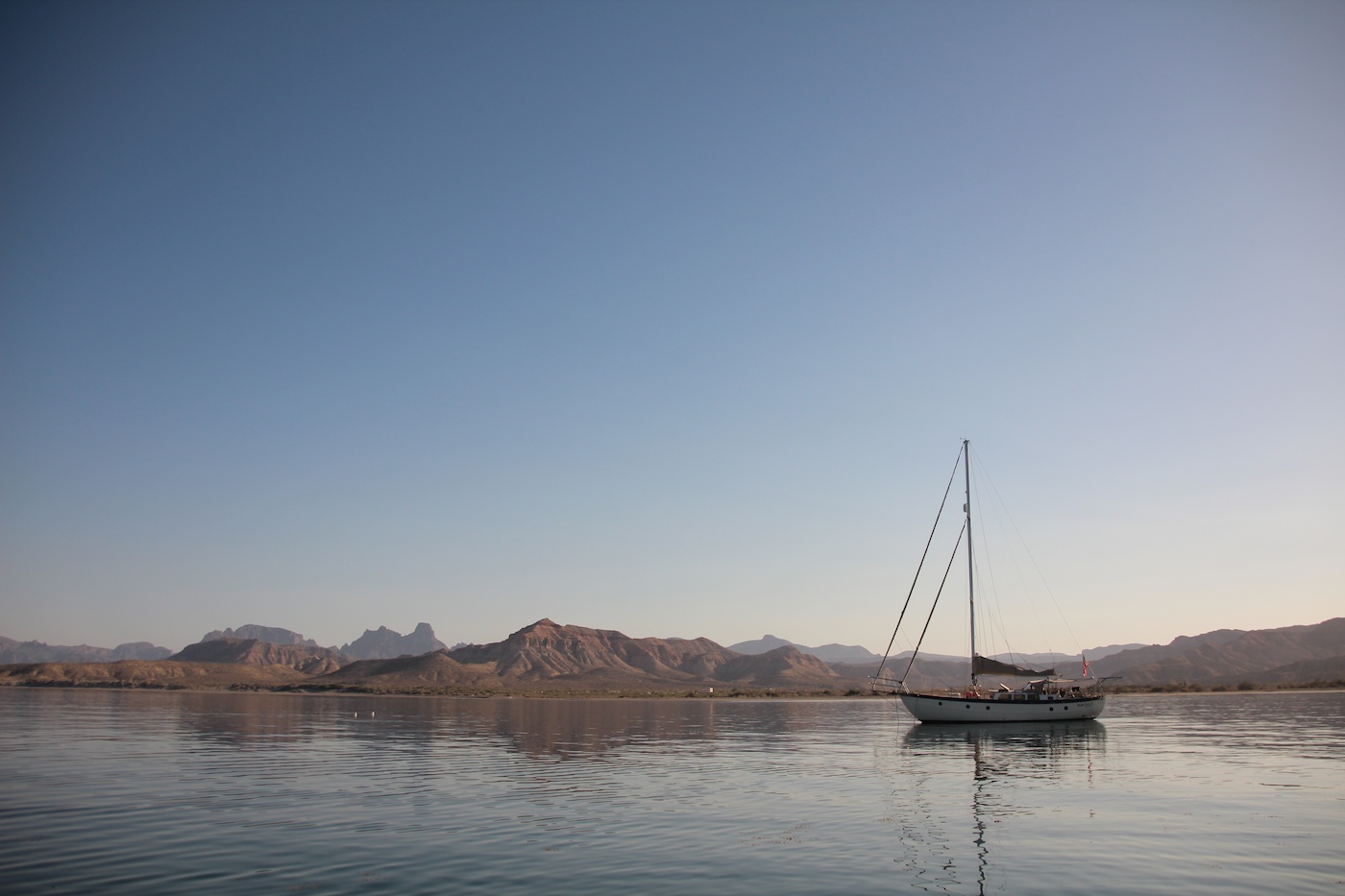
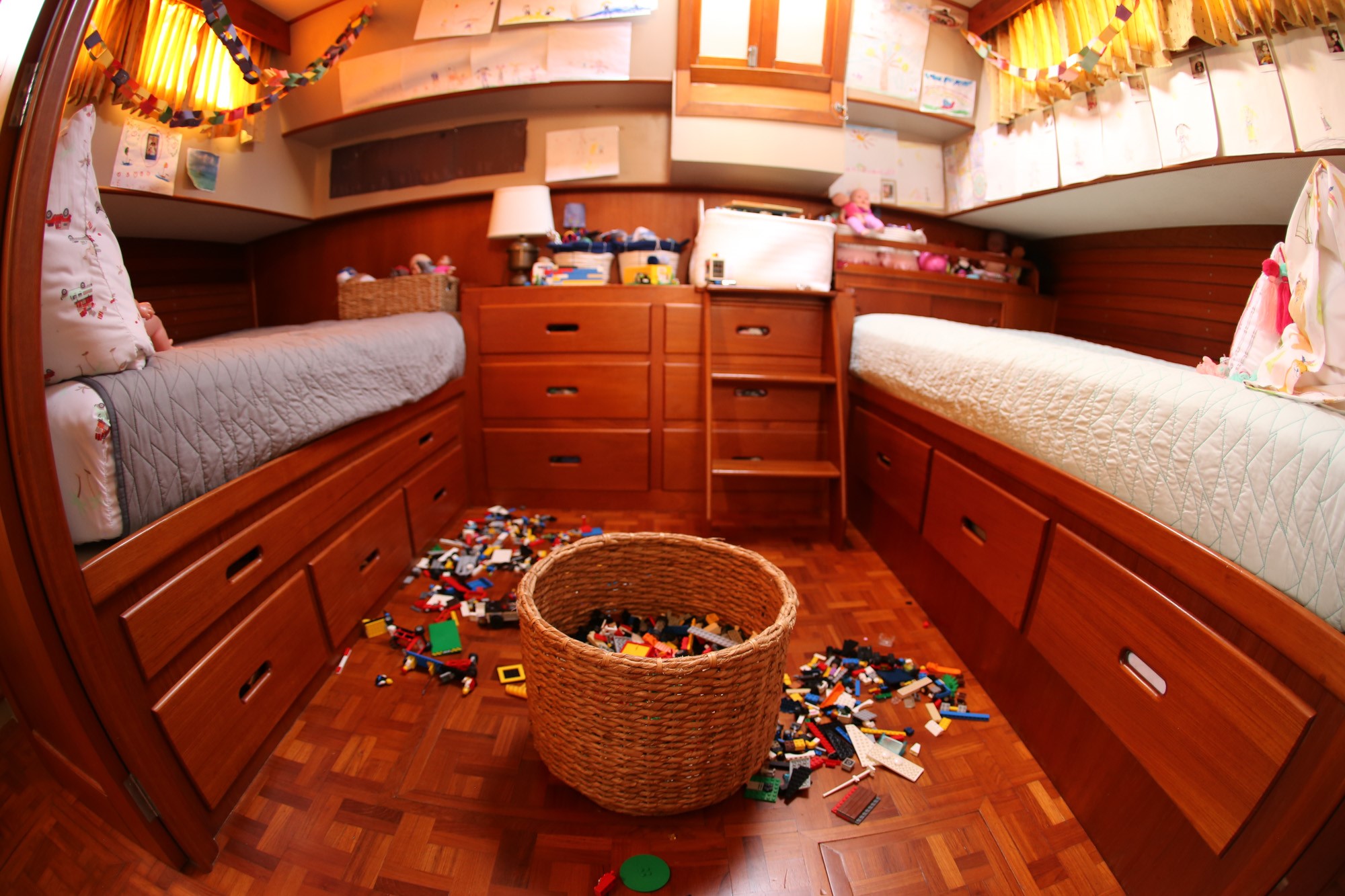
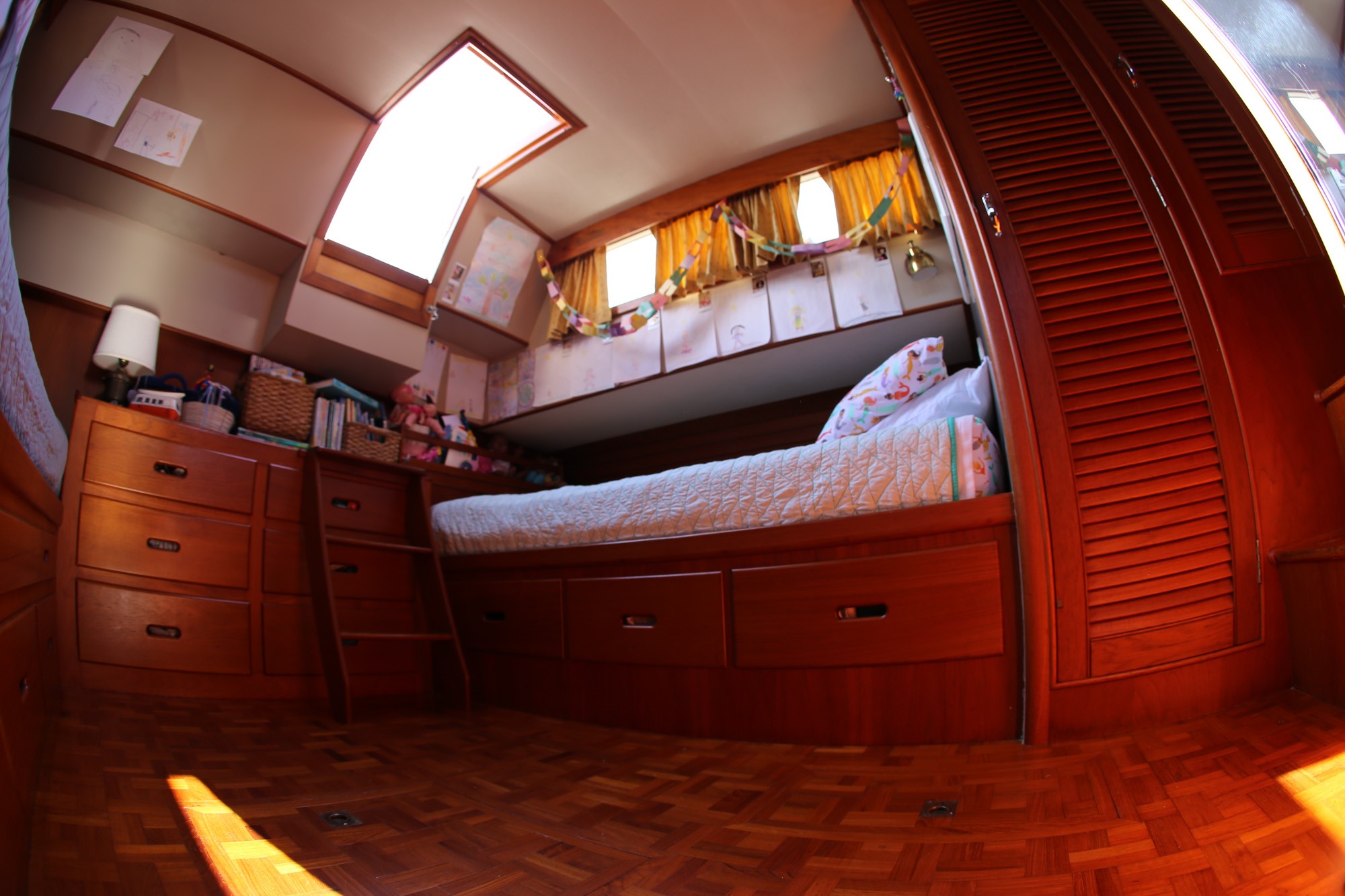
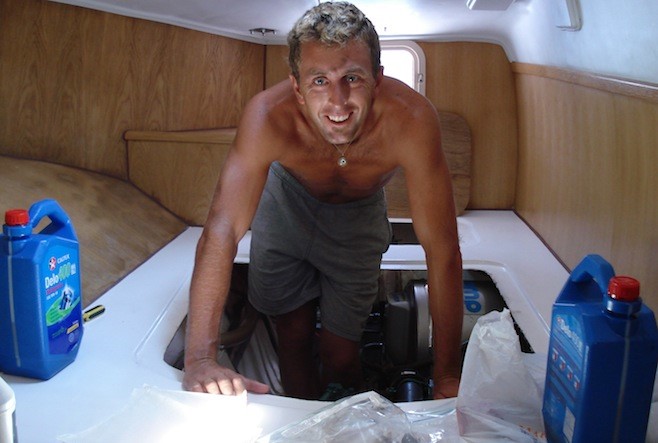
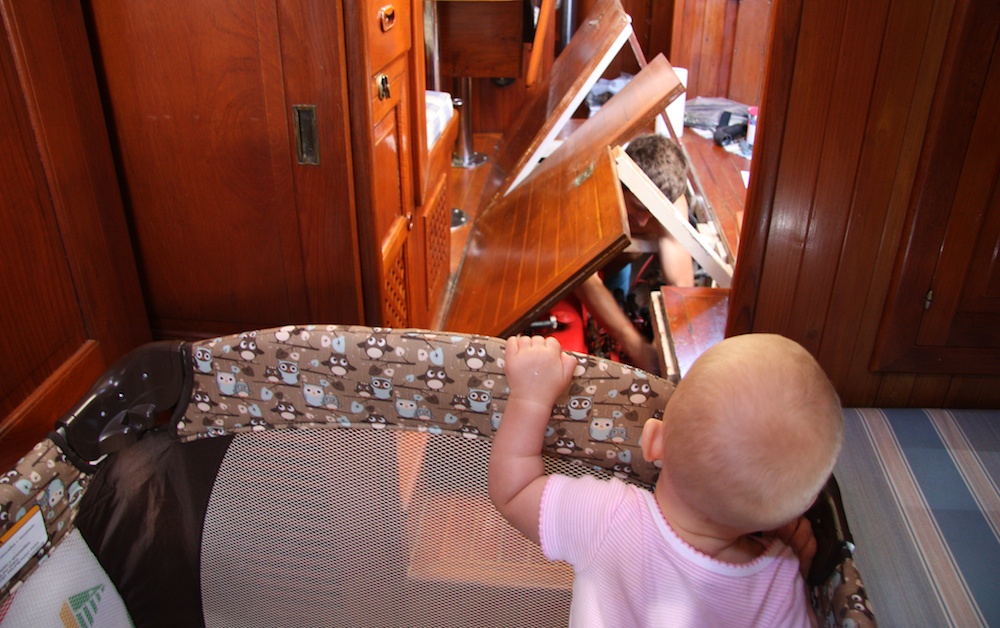
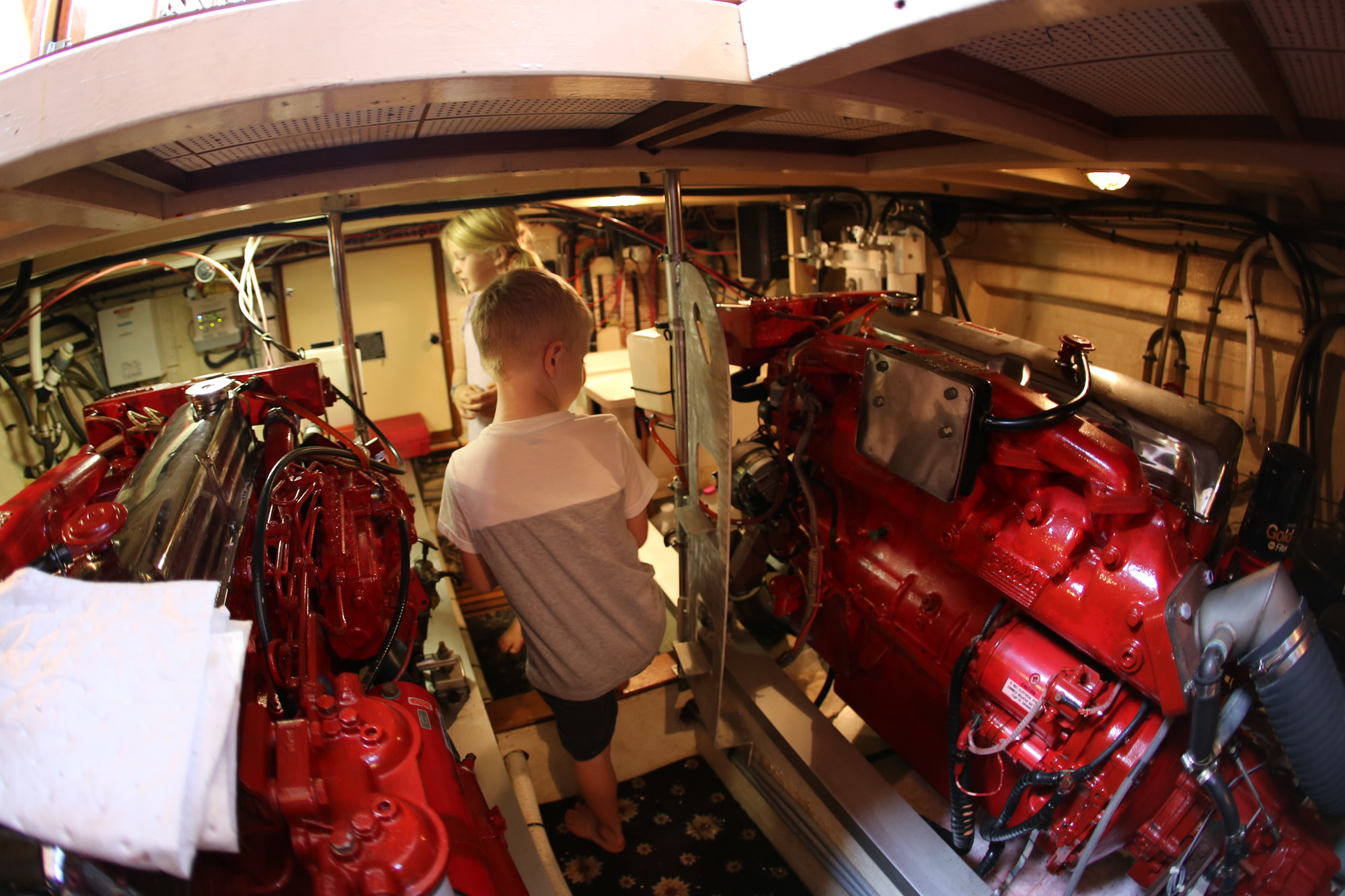
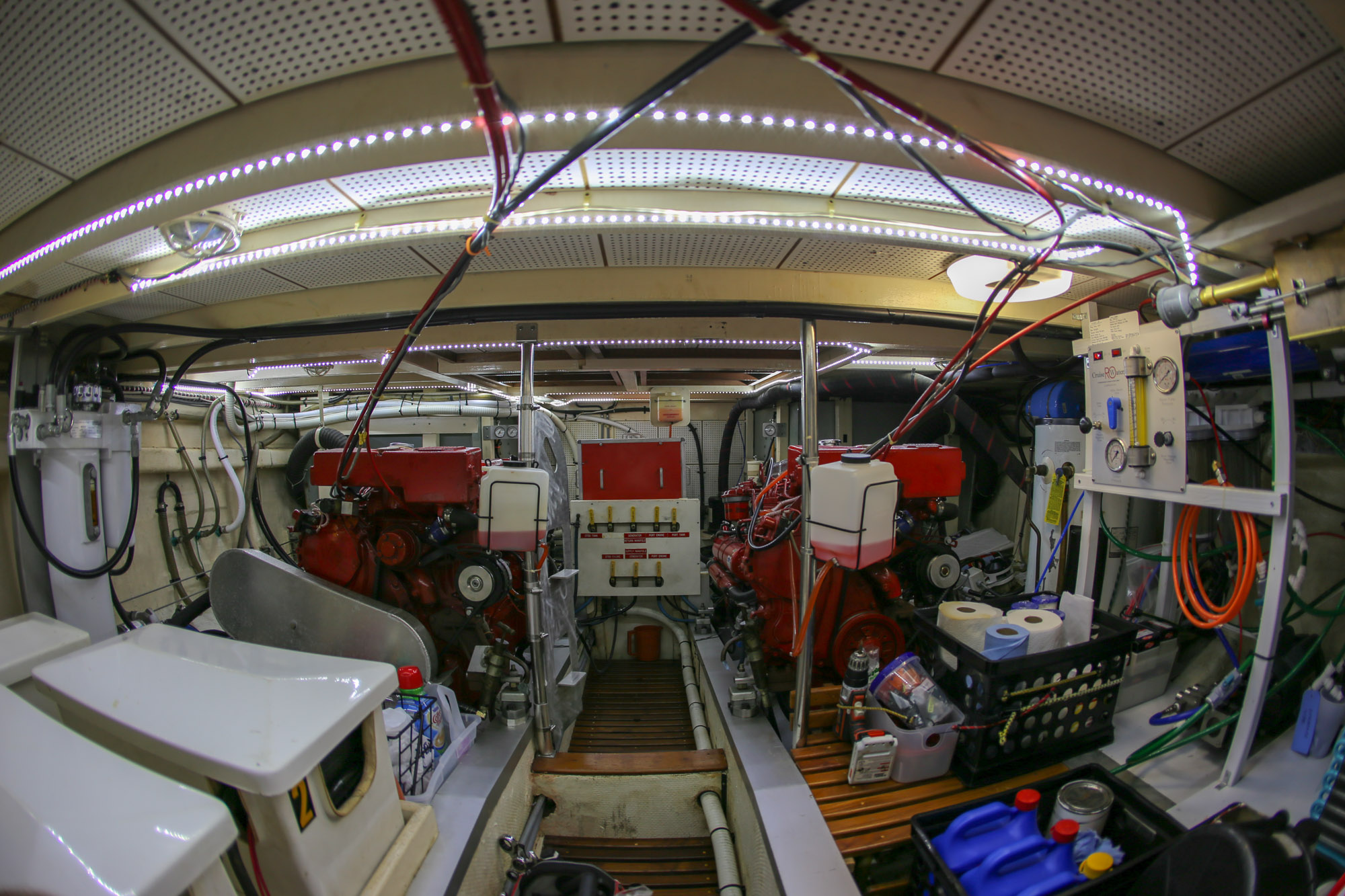
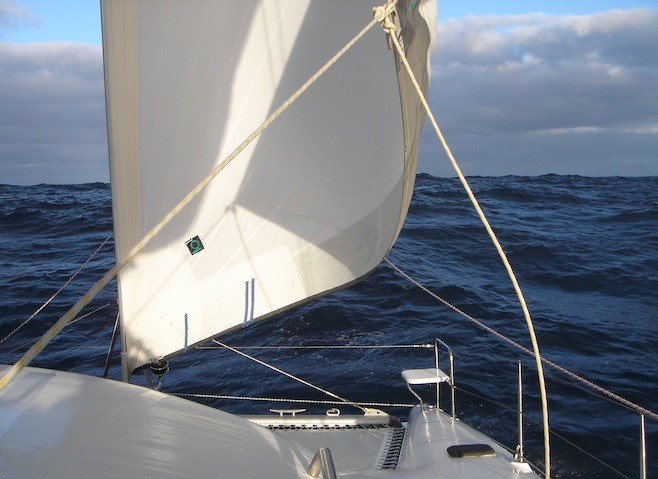
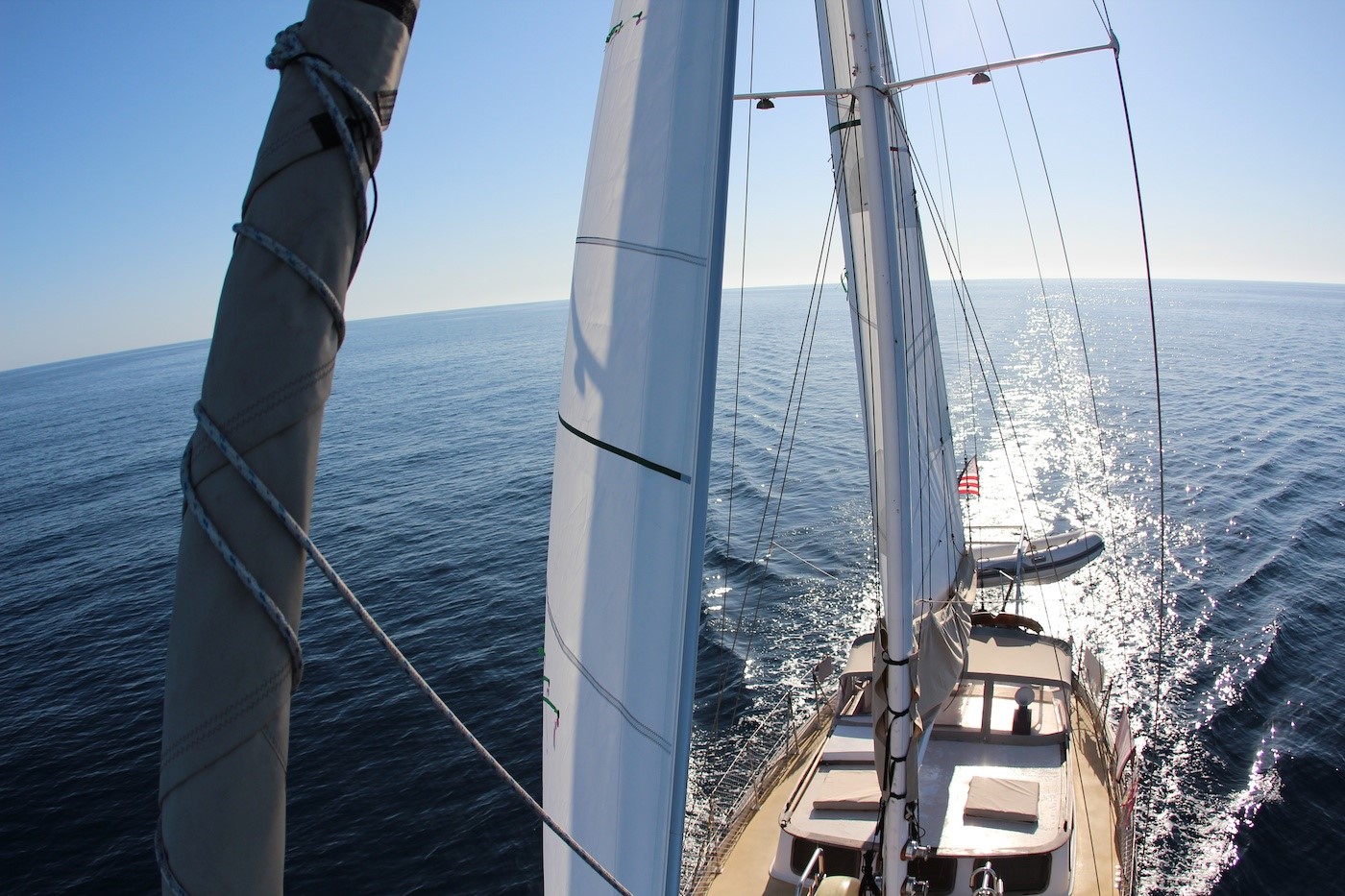
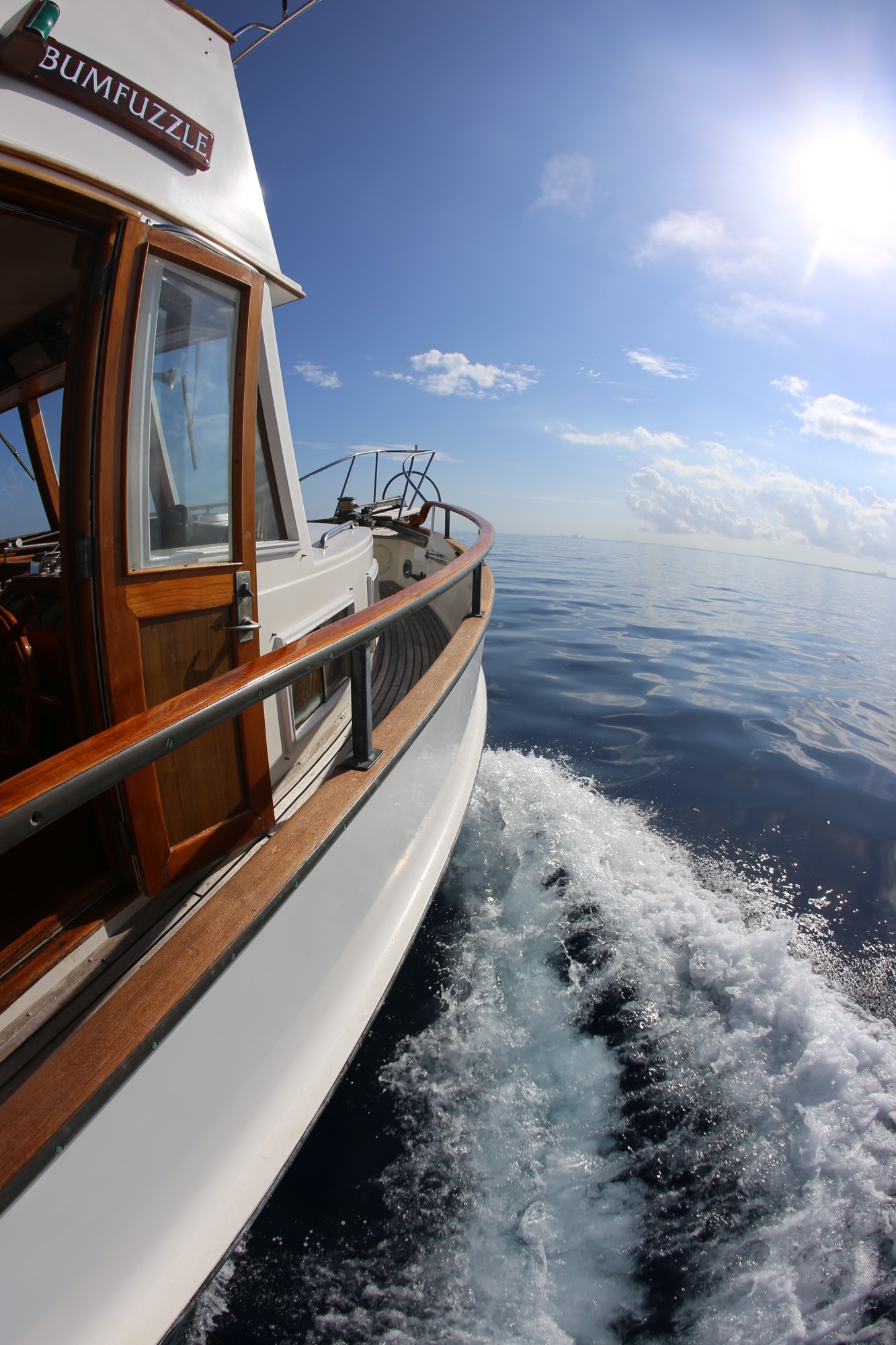
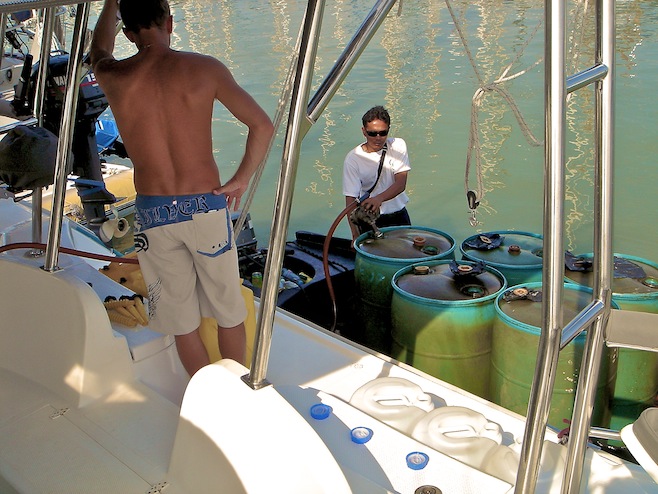
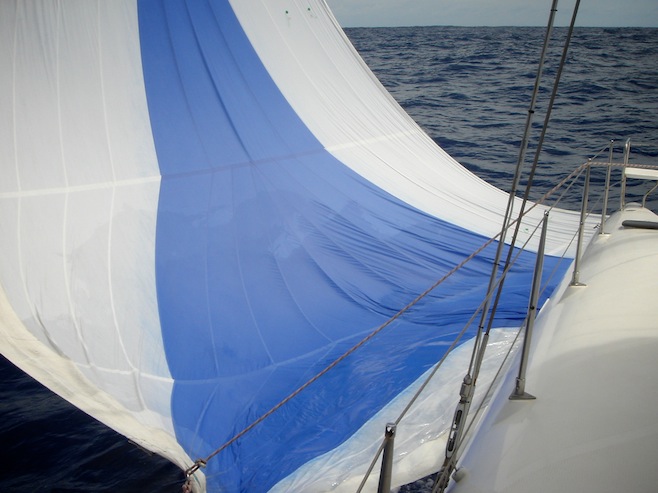
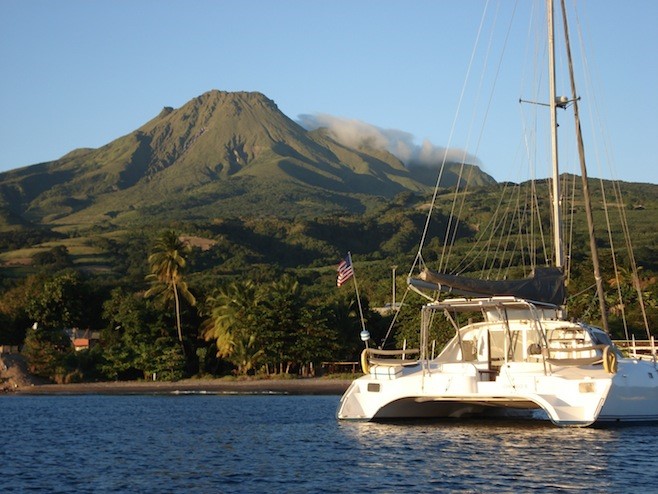

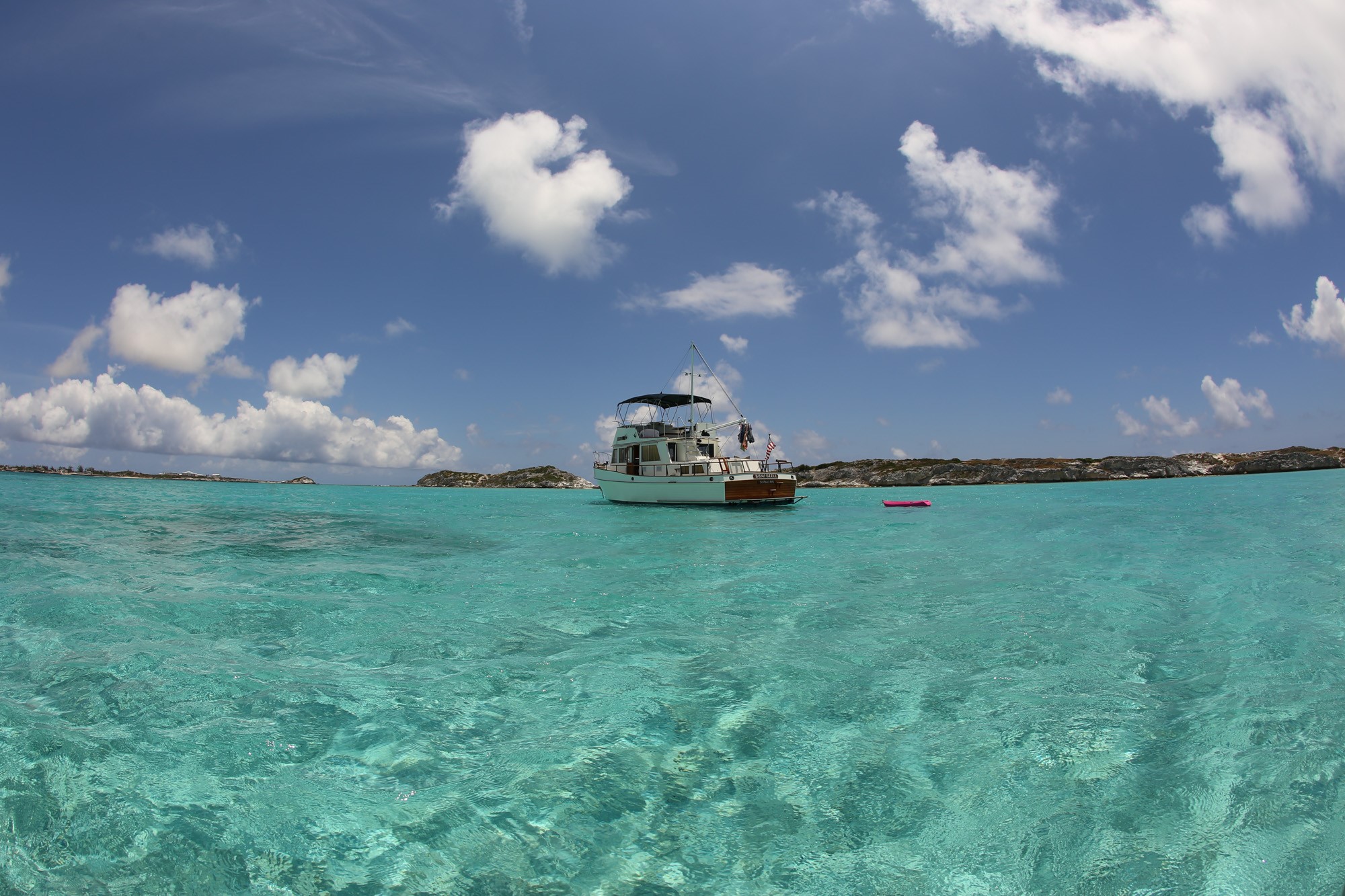
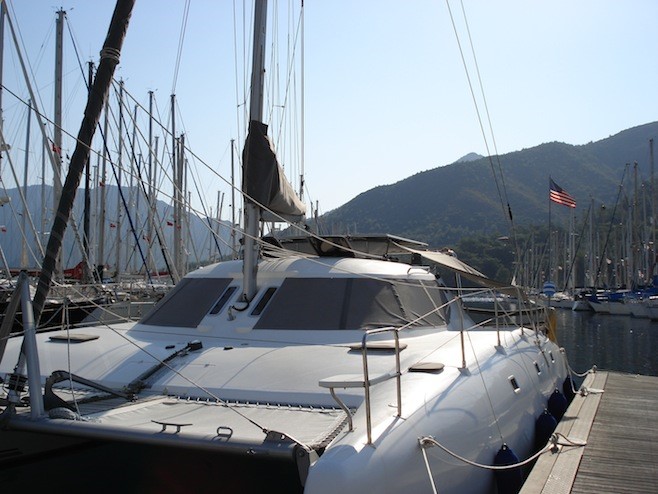
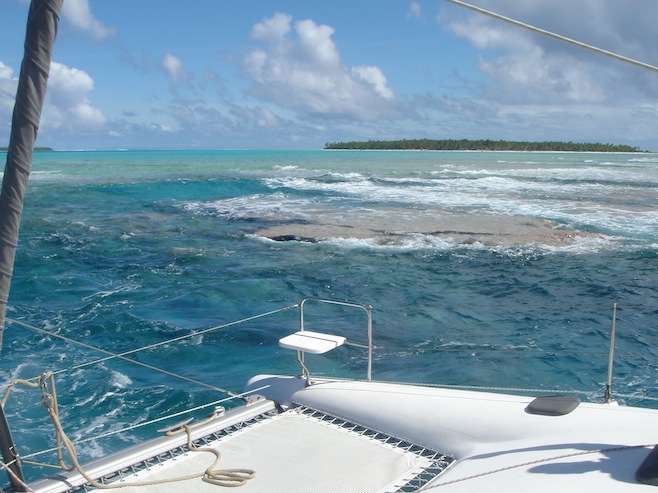
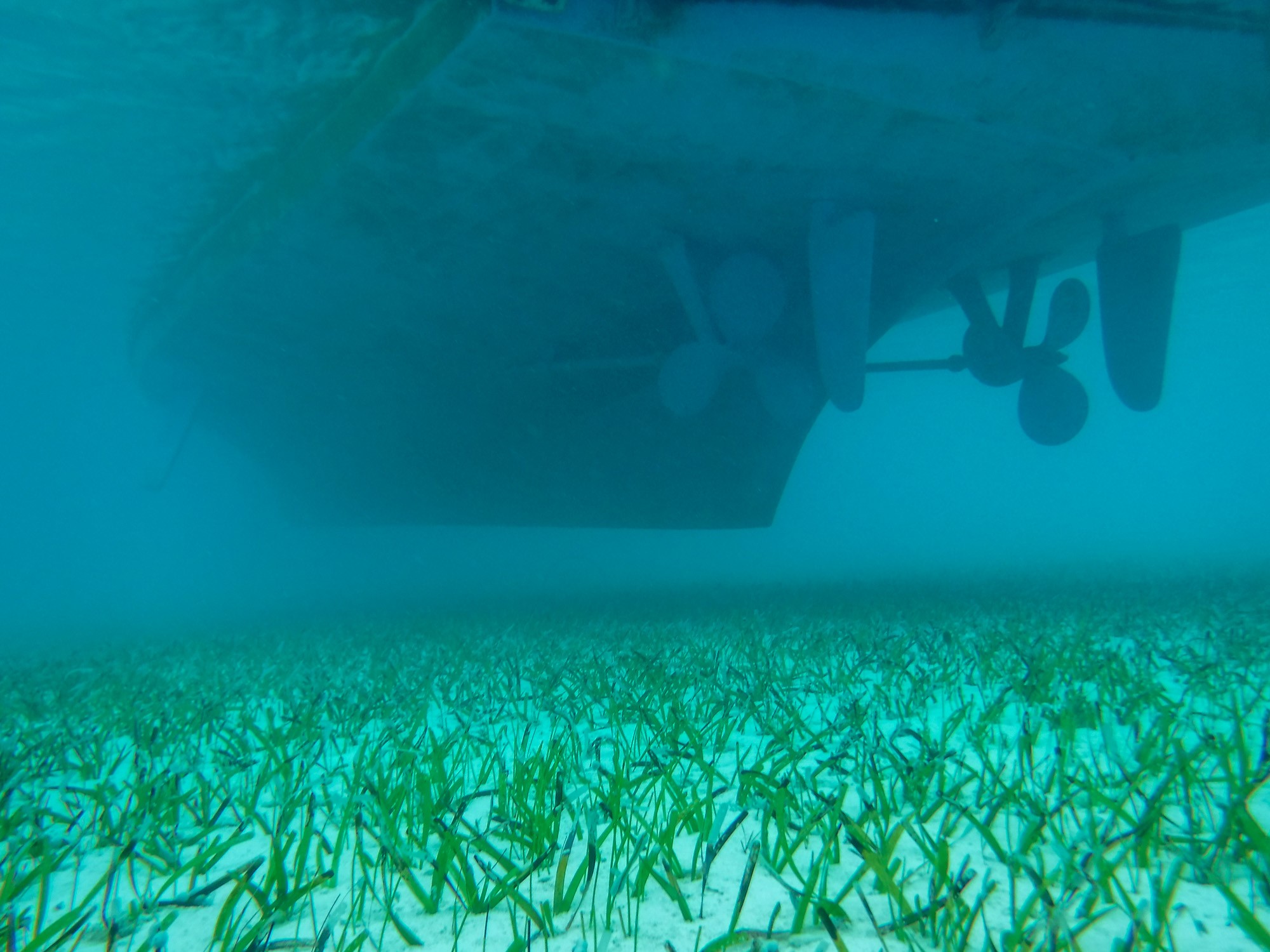
93 Comments on “Trawler vs. Sail”
Great article Patrick. Mono haul sailor to gold looper in a 38 ft trawler. 360 view while sitting in the cabin. Follower from day 1, thanks.
I have a gold burgee too! 2018. Quite an adventure.
Hi Pat: I’ve been lurking around you blog for quite a while now going back to the days on your catamaran etc but have never left a comment. Today that changed as not only do I enjoy reading about your travels and lifestyle but this post really peaked an interest into the trawler option as away to get on the water. I am a Canadian “prairie” landlubber (64) but something about this lifestyle is tugging at me. There would be lots to learn and I wonder if that’s possible. I am active and healthy so maybe?
I was wondering however how hard it would be to find summer storage somewhere where weather etc would not harm the vessel and aprox costs might be, assuming the boat was used only in winter travels in the south and assuming that is even a wise/secure option. Take care.
Turner Marine in Mobile AL has low monthly rates. There’s lots of racked boat storage around to keep your smaller boats out of the weather but these are not hurricane proof either.
I’m the same age as you and ‘looped’ last year (2017/2018)
How nice to read a reasoned argument. Kind of rare these days.
Thanks for taking the time.
Too Spooky! I was wondering what the pros, cons, cost comparisons would be just yesterday after my wife and I decided to look in a Trawler over a Catamaran. Funny enough we also favored the 42 Grand Banks! You’re in my head!
I love it when that happens. Best to check out a couple of both and then you’ll be able to figure out what you like. Good luck! And keep us posted.
This was fantastic — thanks. I’m a wannabe sailor — not experienced — so forgive me if this is a stupid question: Could you sail to Newfoundland and then hop to the British Isles on a trawler? Or would the northern seas be too rough?
No idea. Start googling. Sounds gorgeous!
Nice read. I am a Walter Mitty kinda guy. Other than being a motorcyclist, l do my other adventures through reading and studying. The sailing life style appealed to me but not so much to my wife. Cats seemed to address most of her concerns but their cost is beyond our resources. Trawlers seemed to be the only other viable option. The big unknown was the operational costs, which you covered quite nicely. What I would offer into your assessment is the the start up cost for a cat vs a trawler. That being, one can buy a lot of fuel with the money not expended on a cat. Now this Walter Mitty is off to find a gyroscope to stabilize his trawler while at anchor.
Hi Pat
I’m confused… 4 kts.., I always figured the charter cat was able to get you upwards of 8. our catamaran, a 105mc gemini gets 6-7, granted its a foot shorter and the beam is narrower, but for motoring I’m really surprised at the numbers.. we have got only one engine and its a 27 hp. People have done the same trip you have in their gemini ( not saying everyone should), but this would be in the 80-200 k range for a smaller catamaran.
Next to our boat is a twin of your trawler. As in identical… All shrinkwrapped up… Waiting for the weather to break here.
As alway, we really enjoy you blog and photos. Some day, please write up what you do for the pictures. Cameras,..
Have fun,
It’s almost sailing season here.,,
Walt
This should help with the stability of your trawler: https://seakeeper.com
What a great article, Pat. Have so enjoyed seeing your writing style change and skills increase over the years! Photography skills are superior, also. What a great life you guys have! Keep it up. Health and happiness to all. ?
I applaud this episode. It is 100% informative!
Great stuff, Pat.
We’re trawler people right out of the chute, based on limited experience before choosing that route. Your experience-based review of the pros and cons adds to my confidence that we made the right decision for our lifestyle.
See you on the water.
Onward!
– Guy
Fellow trawler guy and Wanderer Financial fan 🙂
2922 fall/winter
What blue water sailing trawlers are available for sail
Grand Banks, Nordhavn, Kadey Krogen, and many others. Really just comes down to your budget.
I actually went to the US powerboat show in Annapolis this year. There are surprisingly few blue water powerboats that are CE A rated vessels. Most do not have the range to cross oceans. One broker at the show told me “If you want to take your yacht to Europe or even Bermuda, most likely they will be shipped.
Now at the sailboat show the next weekend, boats as small as 35′ are CE A rated vessels.
More about the CE certifications and categories can be found here: https://www.beneteau.com/us/page-actualite/what-ce-certification-means-boat-buyers
Interesting. Thanks for sharing.
Thanks for this very well thought out comparison. We’re going to make the transition to a trawler after our land stint refilling the cruising kitty and I really value your opinions on the subject. Now to find the right boat…
Deb
SV Kintala
Thank you so much very good and honest opinions !!!!! Good read !!!!! Thank you !!!!!
Very well done article appreciate your experiences and words for us looking and pondering what the heck to do ??♀️
right you are! give me a trawler everytime! so much so, I am building one….wooohooo! 32 x 10 x 3 aft cabin, canopied over the front, perkins 4-236. Oyster lugger looking lil thing! for me the “process” is as enjoyable as the “cruising”. however, I am a commercial boat captain…so, i get my fix every other 21 days, ha!
Again, goodonyas! Having said this before, cruising kids have the best perspective of the world, surroundings and self!
I agree that your current boat is best suited for your needs. However, you can still cross oceans with yacht moving companies. Ship your boat from Florida to Europe for an entirely different adventure including the Med and all the canals traversing the continent…
For sure you can! There are even a few Grand Banks for sale over there right now.
Would not having the stabilizers change your opinion? What’s stabilizer maintenance cost look like?
We have a hard -chine American Tug without stabilizers and so far haven’t felt their lack.
Spend a few more bucks and buy a nordhaven and go anywhere
A few more bucks?! The similar size 43 Nordhavn lowest used boat for sale is $499k, a 40′ $359k. For us that would have meant many more years not going anywhere, just working. The comparison between our older trawler and a Nordhavn are not even in the same ballpark. Imho.
“Liked”:-)
Thank you for taking the time to share your knowledge.
Excellent article, Pat. I don’t think there are too many others who even possess your history of cat, mono and trawler ownership, along with actual experience on the water in so many different circumstances. All that, and your fine writing style make for a compelliing and well-reasoned comparison of the various hull-forms’ virtues and drawbacks.
Of course, you COULD cross oceans with the GB by employing one of the float-on, float-off yacht transport companies. 🙂
I did see one minor error: Either the spinnaker halyard you were referring to in your cost comparison was only 100′ and not 150′, or the actual cost was $375, not $250 (at $2.50/ft.). Other than that, I’d say this article is ready for Cruising World!
TJ
If a person can afford a 50 foot, +/-, catamaran, would that be the safest way for island cruising?
Thanks
We don’t compare safety. Everyone is different on what they feel is safe.
Ty :l
Congrat’s. A fair and even-handed review. The only thing I might add is that a bad day on a mono-hull sailboat beats a good day at the office– hands down. Get out there on the water . . . whatever it takes. 🙂
Fantastic article. You are waaaaay more accomplished than I am in terms of distance traveled and experience, but we owned a 37ft monohull for 7 year’s and just switched to a GB 42 Europa and couldn’t be happier. Endless space, stability, convenience, speed, comfort and more. We’re not stabilized through and while it’s a pricey thing to add, I think we may take the leap soon.
Thanks for writing this!
You showed the kid’s bedroom. What does yours look like?m
Hi Maureen, we have the forward cabin. Here are some photos.
https://www.bumfuzzle.com/so-much-water/
Great article with lots of good pros and cons. What do think about a PowerCat? There seem to be a few out there these days in the 40′ range. Still have the beam problem at marinas, but lots of the benefits of the trawler. Been a sailor and was thinking of a sail cat, but recently starting considering going power with no mast, since that would make the ICW easier! Starting to realize I just really like spending time on the water – power or sail.
Thanks for taking the time to post this. We are a few years from ‘retirement’ and are pretty close to pulling the trigger on boat to explore with. I have done, exhaustive research between mono and multi hull sailboats and trawlers. I always come back to the trawler. My current internal debate is between single and multi engine. While every fiber of my body screams multi engine- there are lots and lots of single engine trawlers. We are looking at the Nordhavn, Selene, Fleming, Inace type stuff. So there are options for both single and multi engine in the range of boats we are looking at.
Did the single / multi engine engine part play a part in your deciding on your boat? I see the downside, less range, more upkeep. I know some of the boats have get home motors. I really like 2 motors to maneuver, but hydraulic bow and stern thrusters can solve this. I also appreciate the opinion of someone that is not trying to sell me something.
Thanks again for taking the time to post!
Great article and refreshingly honest. At heart I believe I’m a sailor, but in truth, I have found the wind to be in one of 3 permanent states: Too little, too much or blowing right on the nose! So I’ve sold the 45′ Island Packet and am moving to power.
BUT – what are your thoughts on a power cat? Lightweight, fast when you need it, stable, lots of space. More economical than a trawler. Would love to hear your thoughts. If you can shoot me an e-mail, great!
Terry
I think power cats are the future of cruising. I haven’t owned one yet, so I have no basis for my opinions, but you can be sure that when I do get one I’ll write all about it for the next article. Honestly, I’m not sure what one could argue to be a downside of a powercat. Range, maybe? Looks?
Thanks, PT. Maybe we’ll give it a try! Everything has a trade off, right?
Best, Terry.
Great read. My son loves your blog. We live on a 42ft Kadey Krogen with stabs. Our range is more like 2200 but slower than you. Love our flopper stopper for anchorages that roll. Lots here in Eadtern Caribbean where those monohulls rock. Keep up the great stuff. You inspire the next generation of boaters
Great article based on so much experience you have! We learn from you and others and last year bought a 50’ powercat that is ocean capable (2400nm range), has a beam less than a third of length so shouldn’t be paying extra for marinas, is aluminium so strong, and was less than $110,000 in good (not perfect, but good) condition. We think we have a perfect vessel for us, and your writings just reinforce it – thank you for sharing. Maybe in the future we can similarly share the experiences once we have had them.
Oh, and I have already bought your travel book so when we finally get time aboard in about three weeks I’ll have something to read 🙂
Also, what’s your feeling about electric boats? We’re planning down the track on a parallel hybrid since our diesels are in great condition, supplemented by solar and with a DC genset for longer travel – like your co-authors’ recent video on Top Secret although not to that expense!
Blasphemer! 😉
Hi Ali and Pat,
We met you way back in 2007 in Ft. Lauderdale when we were cruising in our Catalina ’36 and you were just returning from your round the world tour in your catamaran. We are in the process of trading our sailboat in on a Grand Banks 36′. We are in the “old sailors” group, but we’re looking forward to many more years on the water in a trawler versus the sailboat. We loved our Cool Breeze, but one thing you forgot to mention in your comparison is that sailing does require a good bit of physical activity and ability to navigate the small spaces, thus the reason that many long time sailors cross over to a trawler.
Interesting!
We’re only 7 months into cruising and teaching ourselves to sail and I can already see why we meet so many old salty sailors turning toward the power boats. We never spent enough time with sailor to be disillusioned about how much time we spend with sails up vs not… so don’t feel like we have to put on any type of show there.
For us, it seems there are only two major winning points to the (sailing) catamaran over the trawler or power cat:
– the amount of deck/outdoor space (mostly because we never seem to go ashore or leave the boat)
– that sound… y’know, that moment where you turn the engines off and everything goes flat and silent. Thats still the best part of any passage/crossing. As soon as that starts growing old – I think we’ll be right behind you on the powerboat train. 😉
Thanks for the write up. Hope our wakes cross again soon!
Very nice article – thanks. But this article is really a comparison of the boats you’ve had. My Kadey-Krogen can cross oceans on a lot less fuel than your GB. And it has fin stabilizers so I agree completely with the added comfort you mention. But to your point, the Krogen, like a Nordhavn, is a more expensive proposition (but maybe only double-ish or more). And those stabilizers are not cheap to keep. I paid $13k doing a catastrophic fix to mine about a year after we bought our 30 year old boat. I am rambling here because it looks like people are needing context… Yes, power cats are also an excellent choice. Check out the Aspen Powercat if you want one that isn’t too wide for a marina. But now I’m selling, so I will stop.
Thanks again for a very honest article!
@boatguybill
Thanks, Bill, yes it is a comparison of the boats I’ve had. I find it not very useful to compare things I know nothing about.
Great article. But you run a 42 ft yacht on $10/ day fuel? Doesn’t seem possible. I spend more on a ski boat and my car.
We do drop the anchor now and then. We’re liveaboard cruisers not delivery captains.
$10/day is 3.3 gallons/day is 9.9 mi/day – to me. So when out cruising, yeah that seems about right. Some days are 30-40 miles. Other days are zero, of course. But I appreciate your skepticism. 🙂
We actually have a 46’ GB 1997 without stabilizers (quoted them but $60k-$70k project) and we are considering to sell and buy a newer sail cat, totally agree on those two reasons plus less dependency on a generator (easier to have more solar capacity), our distances are relatively short, we usually boat between Puerto Rico, Vieques, USVI & BVI’s, appreciate the shared experiences posted here, happy boating!
Yes, we’re still amazed that a previous owner installed the Naiad stabilizer system on this boat and then did virtually zero miles and sold the boat two years later, basically eating the entire cost of the upgrade in the process. Ouch.
Your assertion that sailors motor 90% of the time is new to me. I’ve windsurfed, sailed beach cats, and sailed a 32 ft Hunter around the Bahamas for a couple weeks. So I’m not some great yachtsman. I don’t have the patience to sail at 5knts. I was figuring I wanted a multi hull capable of 15 to 20 knots to sail the Bahamas and then the islands. Maybe a trimaran that can fold up to get in a marina. 32 to 40 ft. Just for me and a girlfriend. Does not need to be fancy. I figured sail would be cheaper than power. Thoughts from anybody are appreciated.
Sailing is only cheaper than power propulsion in that the wind is free, while fuel isn’t. But everything involved with engineering a way of capturing that free resource – mast or masts, sails, line and all the associated ways of handling it, maintenance, etc. – are far from free. And yes, sailing vessels typically are propelled forward a majority of the time, reportedly, by use of the “iron genny” more often than sails.
That’s often because the wind doesn’t cooperate with someone’s plans – have you ever noticed that it always seems to blow from the direction you’re headed? 🙂 And the wind is often blowing too little or too much – that sweet spot in the groove is highly elusive and inconsistent. Sure, when everything’s just right sailing is magical. Too bad that happens so infrequently.
I wouldn’t try to dissuade you from pursuing your travel dreams as you’ve envisioned, Sean, and sailing around the Bahamas and the Caribbean islands can be idyllic. Still, you’d be well-served, I believe, if you gather as much info as you can in advance of committing too much time, money and effort to a single way of making those dreams a reality. The learning curve can be both steep and expensive.
TJ
His assertion, however unfriendly (or un-ego-centric)… is fairly accurate.
We also had no idea before moving onto a boat that we would spend so much time motoring (in our sailing cat) after leaving the Bahamas and continuing southward…
and I low that we actually sailed many a crossing that others motored to avoid high winds and seas…
It may not be friendly or positive, but the simple fact is… that most people talk about the fastest speed of their boat rather than the true average speed, and most don’t choose to leave a safe anchorage on days that could provide high speeds because high winds also typically mean a less smooth crossing.
So once you’re underway and living aboard the only speed that truly matters is the low or average speed under low to normal winds… not what the boat can/could potentially do or might possibly do under the highest possible conditions (that you’re unlikely to leave under with your home, family, kids in tow)…
so if you don’t have “the patience to sail at 5knots” you probably also don’t have the patience to actually live aboard and sail everywhere you’re about to go… which means you’re actually advocating for the trawler or power cat.. and good on you if that’s your preference… but somehow I don’t think that was the intent of your response…
Thanks. I definitely wont be sailing in a gale.
Well this launched three months ago and is still enticing comments. Thanks again for doing this, it has been enjoyable.
Yes it is getting new reads as our friends, Jason and Nikki, shared it on their recent post. https://www.gonewiththewynns.com/cat-mono-price-performance
Sounds like it was a last ditch attempt to get a companion to go with him but she would not even try!
Hi Pat and Ali,
I’d missed his post and saw the reference to it on the Gonewiththewynns YouTube blog. It s a great piece of writing and has helped to confirm my assumptions, so many thanks!
It’s always enjoyable to see your posts. All the best.
Bob
Hi Pat and Ali,
I’d missed his post and was directed to it from watching Gonewiththewynns YouTube . Thanks, it’s a great piece of writing and it’s good to get such a comparison, it cements my thoughts on what I need to consider.
I continue to enjoy your blogs , all the best!
Bob
Anybody ever thought about touring the islands using a ground effect seaplane?
As an old former sailor, I’m curious on how the boat was named “Bumfuzzel?
Bumfuzzle definition: To be confused, perplexed, or flustered or to cause confusion. At the age of 28, we were confused on what to do with our life. Things were going good, we had some money in the bank – buy a house in the ‘burbs? start a family like all our friends? or….travel! So we came up with a plan to buy a boat and make some memories – at first it was to be for a year…that all changed. Plus it is one word, easy to remember, and no-one else would ever name their boat that! 🙂
Very informative. We are getting ready for a full time adventure. I’ve always wanted to live on the water, trawler seems ideal for us. We’ve done the airstream and don’t want to trailer anything anymore. My husband thinks a small RV would be more economical than the trawler, any thoughts on that? Two totally different experiences, I’m fine with either, but just looking at cost, what’s your take. Thanks, have loved following you since the very beginning.
I expect a land based RV would be a lot cheaper to run that a trawler in the water. I only know boats but they require constant maintainance and suffer from corrosion issues in a saltwater environment. On cost alone RV has to be cheaper hands down . But is it the same experience?! Watch ‘gone with the wynns’ who transitioned from 6 yrs in RV to sailboat life and are already in the pacific after about 3? Yrs. they are exceptional people but despite all the extra work they much prefer cruising on a yacht!
Hmmm, nice analysis from someone who had owned all 3 boats discussed…
This has opened my eyes. How do these boats stack up in regards to crews? Which boat is easier to manage single handed, with 2, with 4 or more.
As I get older, the inability to do major ocean passages is less of an issue. I’m more of an island hopper/costal creeper now.
This couple hundred grand burning a hole in my pocket hurts!!! Ouch, it hurts!!! Help! 😉
Interesting read, since I own a catamaran. Have sailed it many thousands of miles and even cross the Atlantic singlehanded, but don’t care to describe myself as a ‘sailor’ i’ve frequently bemoaned the poor motoring speeds, wind in the wrong direction, lack of wind, choppy seas etc..
I would love a trawler, but unless it could at least cross the Atlantic, then for me it’s out of the question. You state only a small fraction of people cross oceans. That is still probably thousands of sailboats a year.
Any electric trawler with big generator and lots of solar, might work, but going back to pure fossil boat in these times could be considered a backwards step for many.
The cost of the fuel is also not so inconsequential. In Europe, and here in some of the islands of the Caribbean, diesel can be €1.45 per litre. Regardless of the cost of rigging (which I did replace at €3,500, and a sail at €1,500) not many people could happily shell out hundreds or thousands up front each time they stop.
Been down almost the same route. Small runabout, Small sail boat, Bigger sail boat, Even bigger sail boat, Floating Hotel Sailboat (Aft Cabin Center Cockpit) —then we slipped –Grand Banks 42. We had traveled up & Down the US East Coast and the Keys and West Coast of FL with the last sail boat after retiring. Found sailing to be too much work and not much sailing anyhow in Florida–also too hot to be outdoors. Bought the GB brought it back to NewEngland-traveled the “East-Coast Little Loop–visited Erie Canal, Great Lakes and Rideau Canal Canada. Had a great time for 8 years. But alas the work on an older GB 42 with twin John Deere engines, extensive systems of electronics, plumbing, HVAC and miles of Teak beautiful but labor and cost intensive; forced a realization of $$$, age and work and the boat had to go. We now have a Class B, MB Sprinter RV and traveling the inside of the country. Anchoring ? Storms? Dinner? there’s always a Holiday Inn!!! That said were looking for a Pocket Cruiser like a Rosborough for inland cruising and towable behind the RV. After all were only in our late 70’s
“Nordhavn” produces trawlers that are proven to be excellent ocean crossing vessels with a range of 3000nm and more.
I thought I was pretty clear that this article is regarding boats in a certain price range. I doubt anyone shopping the Nordhavn market are reading an article debating trawler vs sail.
Valid retort.
So I am researching boats to purchase as our last child leaves the home soon. While you might have put a price in the first post, I actually went back to read that part, it is the concepts that are really most relevant. Crossing the ocean was in my first list of things I ‘needed’ from my trawler, but I soon learned even in the ‘Nordhavn’ people use bladders. I like so many parts of sailing, but also like the freedom in the trawler of not waiting on winds, or being able to go any direction. I research to see if there is a boat that will meet my trawler needs, and do the great loop which has been a bucket list item for a decade now. Do we get a boat with fin or gyro stabilization. What is the process of hinging a radar arch, or dry stack. To this article, blog, post… From the people that have done sail and trawler- why? The differences? Do I rethink and do a motor sailor? Do I spend $200,000 or $900,000- or where in the middle. In my life, what does my wife need to boat to do… maybe I need fin and gyro stabilization 🙂 Pat- thank you for putting the time into your post. I will attest people looking at Nordhavns are reading your post, and learning from it. Will we trawler, sail or motor-sail… I do not know yet. My list of ‘needs’ changes as I learn more. Anyway- thanks for letting me into your story, your thoughts, your experiences…
Thanks, Jim. Good luck in the search.
Jim, the boat for crossing oceans is quite a different boat than the one for doing the great loop. I can highly recommend the Great Loop but you certainly don’t need a 200K boat for that. Try an old 34′ mainship for that and go to the Bahamas in the same boat. Then, if you’re still willing to cross oceans, go upscale.
For the loop you won’t need fins or gyro if you don’t mind waiting at anchor or in the marina for a weather window.
My wife made a blog: https://thewanderingstar.blog/
Dirk,
In my research that is about what I have learned. Part of what drives this is my wife would like certain, comforts… So I suspect we will be in something pretty new, pretty updated etc. Things like- walk around big beds, no bow beds for the master, enough room for our family to jump in and out, and we have 4 kids, one with a husband. She also wants friends along for extended periods of time. Big brings her more comfort. I suspect we will be in the 50+ range. Selene 54, or 53 with twin screws, or the Nordhavn 52, 55 or 57, or maybe a Marlow. I look forward to reading your wife’s blog!
I hear ya. That’s how we ended up with a 40′ Mainship with a walk around queen bed.
FWIW, imho, anything over about 45′ is just too big for the loop.
Feel free to email me.
I know this is an old post, but it was just what I needed to read. I’ve been a lifelong sailor, raced sailboats, did some light cruising, but never had the time, between career and kids, to take a “long trip” a round the world adventure that I wanted to to. I dreamed, sure enough, but never had the time or even the support (first wife hated sailing).
I remarried late, to a go-fast powerboat girl (38 Scarab, 48′ custom) who also had no time for cruising or “just messing about in boats”, but who really loved the water, as did her kids.
I kept my small “divorce” sailboat, but it’s set up for racing and while we enjoy it, it’s too small for more than daysailing. We also planned on moving up when it was time, but wasn’t sure as to what might work best for us. We are both getting to that empty nest age, when we start thinking about the next stage. We couldn’t even make up our minds about what the next boat would be. Express Cruiser (ugh, IMO), catamaran, or sailboat, or heaven-forbid, trawler?
We spoke with a good broker (friend) who asked us some important questions, some of them you went over in your piece. How much cruising will we do? How far? How much time? In the end, we realized that, even retired, between our businesses and kids, , at first, to coastwise trips of a few hundred miles, a few weeks to a few months, at most. My wife grew up going to the Bahamas. She still has friends there. How could we do such a trip from Texas in a “powerboat” even if we hopped down the coast? I assumed no powerboat of any sort was an option for island hopping.
Trawlers were low on the list. I thought of “trawlers” as “I’m too old to sail” boats and my wife thought of them as “too slow, to uncool to go, boats”. You gave us a different perspective. So did our broker, who now has us looking at modern trawlers. Thanks for the info and the backup to our decision.
If your plans only include the Caribbean then I assure you that you will be happy with the choice of a trawler. Congrats on coming to the right decision before it’s too late. 🙂
Came across your article. Well written. We have just completed what will be our last Gulf of Mexico crossing aboard our Catalina 42. It will be our last crossing because after 7 years of wonderful adventures, we’re moving to a trawler. A GB46 has caught our eye…..but, it’s not stabilized, as are most trawlers in our budget. The after market project appears unlikely. Overall, we would be at anchor more than at sea. Based upon your experience, if your GB42 did not have stabilizers, how much of your assessment would have changed? Thanks
We’re anchored in the USVI right next to friends on a GB42 w/o stabilizers and our experiences are entirely different. Frankly, if we didn’t have stabilizers on the GB I don’t think we’d be anywhere near as happy. I’d keep searching, stabilizers do not seem to retain much, if any, value in resale. Find a boat that has them already.
I’ve been selling Kadey Krogen for seven years now and can say with pretty good certainty that stabilizers add about $20k to the resale value of a Krogen. They cost about $55k to install at last inquiry. I have them on my Krogen and bought it specifically for this (and other) features. I had it on my requirements list a lot because I plan to go from Seattle to the Sea of Cortez upon retirement. And I don’t see making that trip without them.
So cool to learn about you and share your adventures. We have a GB42 woodie built in 1968 (hull 55). We cruise the Atlantic maritimes so it’s unlikely our wakes will cross any time soon, but who knows!
Loved seeing the beautiful interior shots and comparing with ours. We haven’t seen many others.
Only thing I’d add is that a sailboat with good sailing performance especially in light air can make a huge difference in passage making. Not only do we sail more than most in our vintage Tartan 40, but we can also motorsail at 6-7 knots at a fuel sipping 1200RPM in zephyrs. But, maybe most significantly is it’s worth getting the powerplant right in a sailboat. We easily cruise at 7+ knots at a reasonable 1gph which closes the gap on the trawler.
No way we come close in comfort, space, storage, of course. I’m jealous. Helpful to know about the stabilizers in case I every jump
Hi!
I love the life you guys have made! I am looking at a 1973 49′ Grand Banks Alaskan, to live aboard in a marina while we still work in California, 2 boys, 6 and 2 years old. The boat hasn’t been pulled out of the water since 2007, which seems crazy long to me. But down below I pasted the specifics that were done. I’m not sure if you guys are in the habit of giving advice, but if so, does this seem too long to have not pulled the boat out? or do you think it could still be a solid boat?
Thanks so much, I really enjoy seeing what you guys do!!
In 2000 the boatyard wooded the hull (stripped off all the paint) and checked the fasteners (solid bronze 2” or maybe 2 1/2”). They were impressed with them. They brought it back up with a really good primer and Sterling Linear Polyurethane (LP) as the white topcoat and blue bootstripe along the waterline and on the stack.
-In 2007 the boatyard did the topsides with Sterling LP as well. Areas that are plywood have not held up as well as the hull, which is full thickness 1” Honduran mahogany. During that round, I went after all areas with dry rot and used Smith’s penetrating epoxy, which in essence displaces all damp wood with epoxy, killing the dry rot. I tell people this boat is 90% wood and 10% epoxy in a jovial fashion, although not that much, maybe 2%, it has made a significant difference in how things have lasted. After all of the penetration and fillers where needed were in place and the surface ready for primer and paint, I would again treat with the penetrating epoxy as a first line of defense barrier. During this time I also put a router round on all of the hard edges of the lumber supporting the walk around and added AB epoxy on the inside angles to make it way easier to clean. It has held up really well. Prior I had noticed on all of the hard edges the paint would crack before I rounded them, and mold would sit in the tight right angled corners, so the AB used as a fairing compound really helps with that as well.
Hi Meagan, Unfortunately I know less than nothing about wooden boats. Personally, they aren’t a headache I’d be interested in taking on, especially a boat of that size. But that’s an individual choice. I don’t know just how hands on you all are or if you have experience with this sort of thing. However, best of luck to you with whatever boat you choose. It’s a great life indeed.
Trawlers are less likely to be hit by lightning strikes than sailboats.
An analysis of 10 years of lightning claims reveals which boats are most at risk. The probability of a lightning strike by type of boat are as followed.
(chances per 1000)
1. Multihull sailboats 6.9
2. Monohull sailboats 3.8
3. Trawler/Motoryacht 1.5
Loved your book and loved this article. Very informative. Thank you!